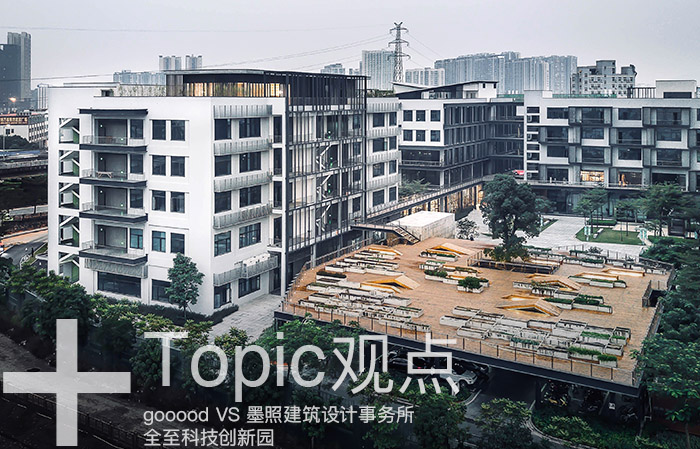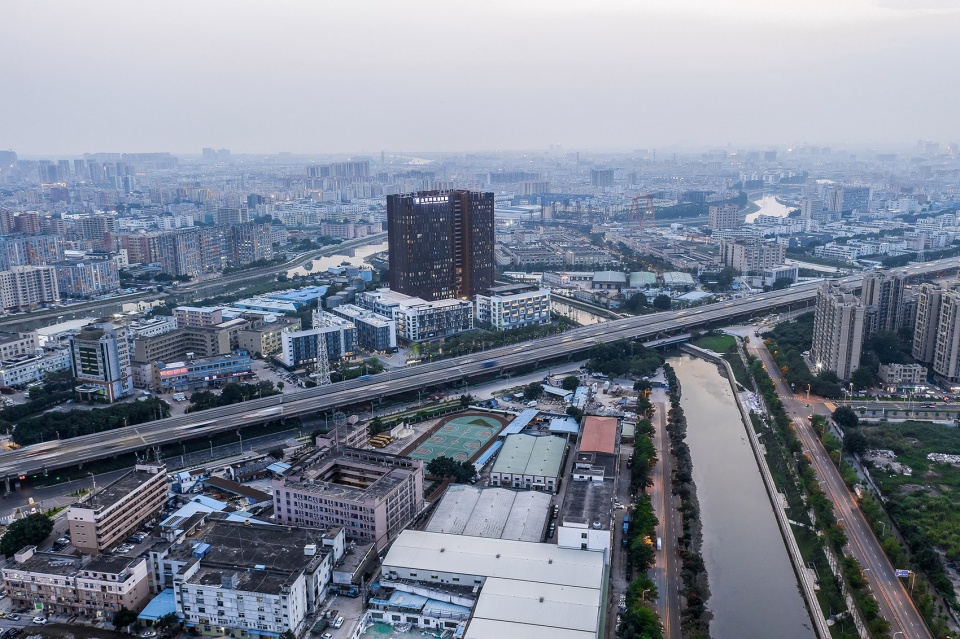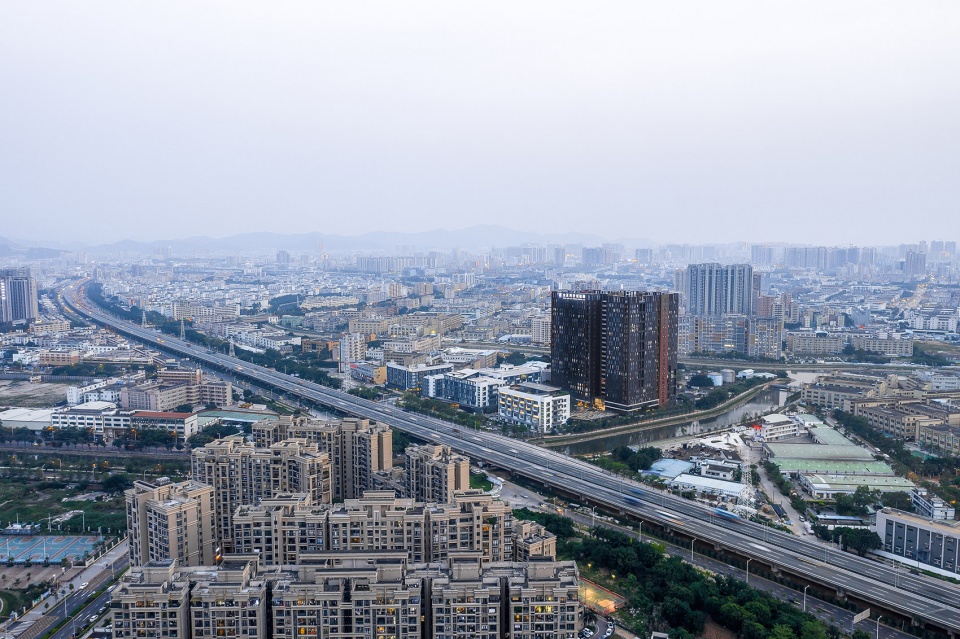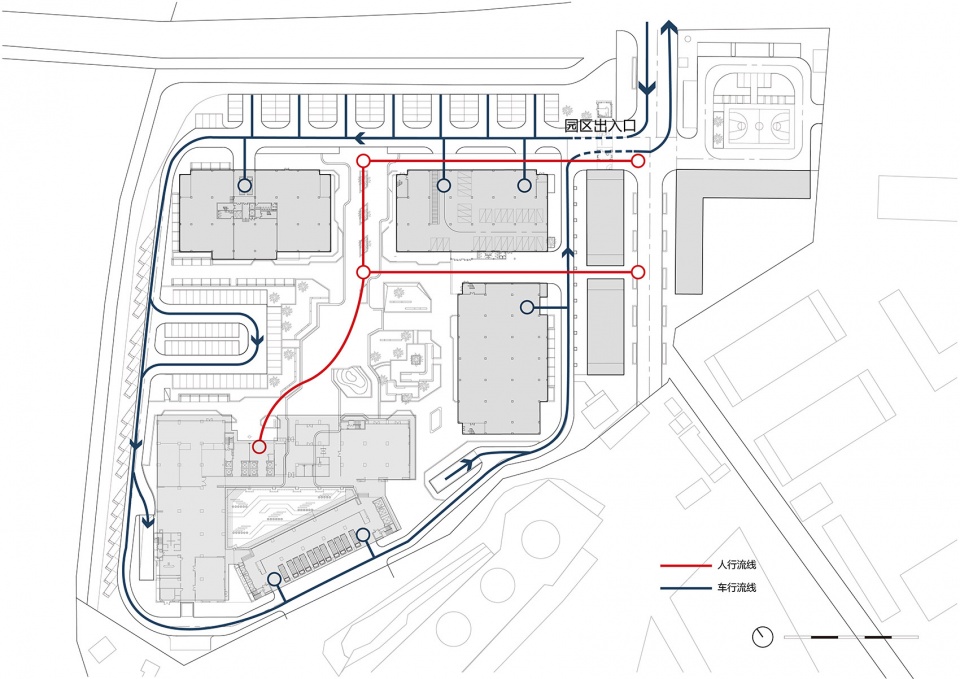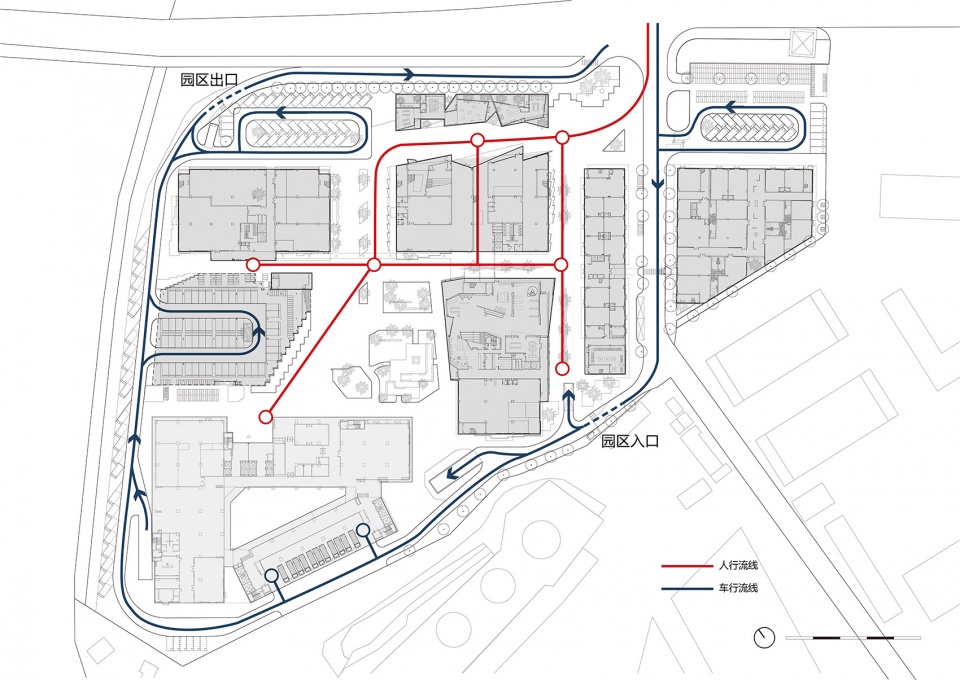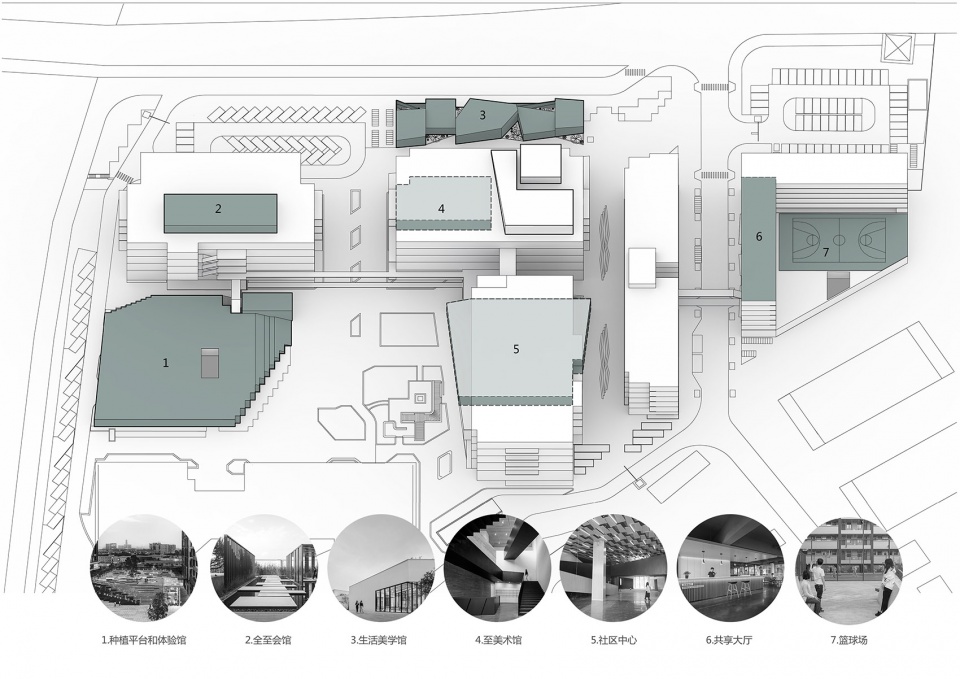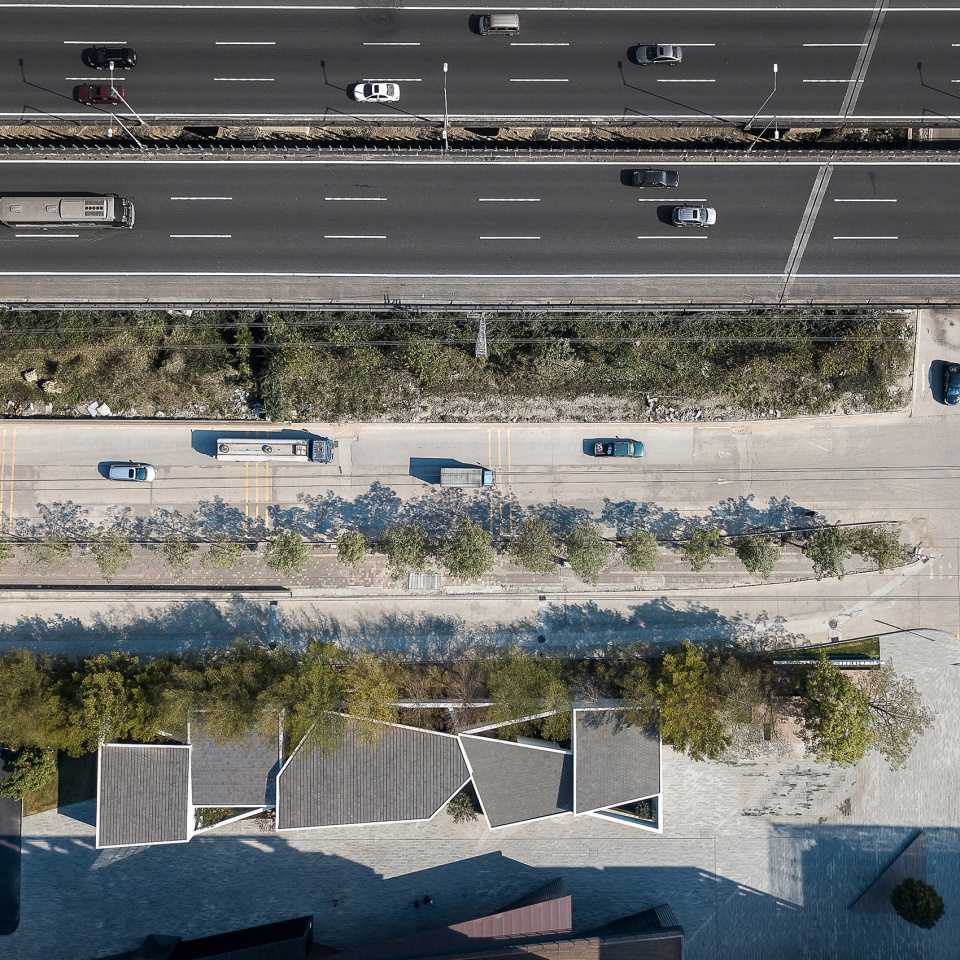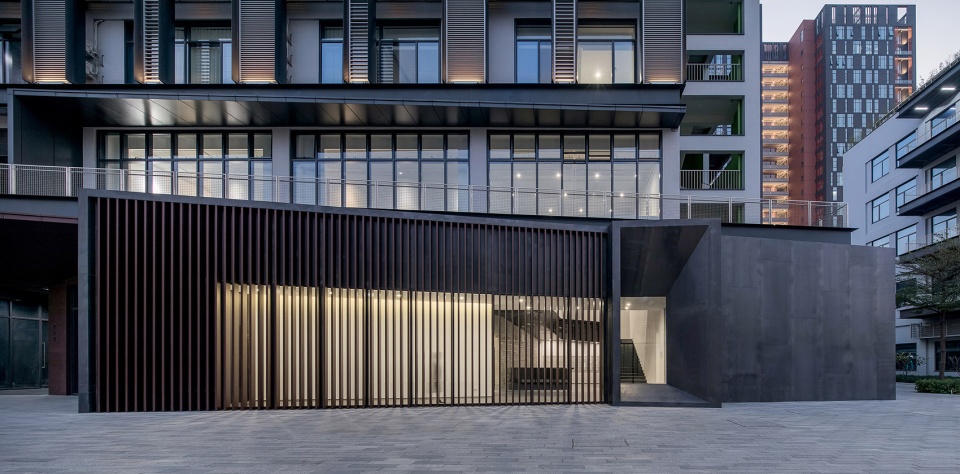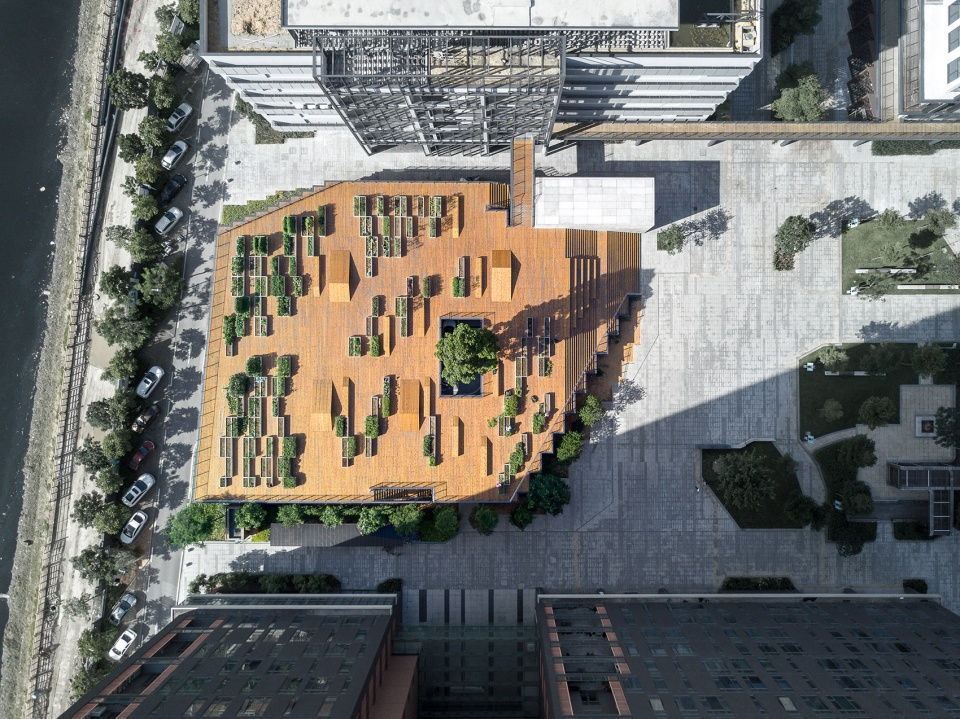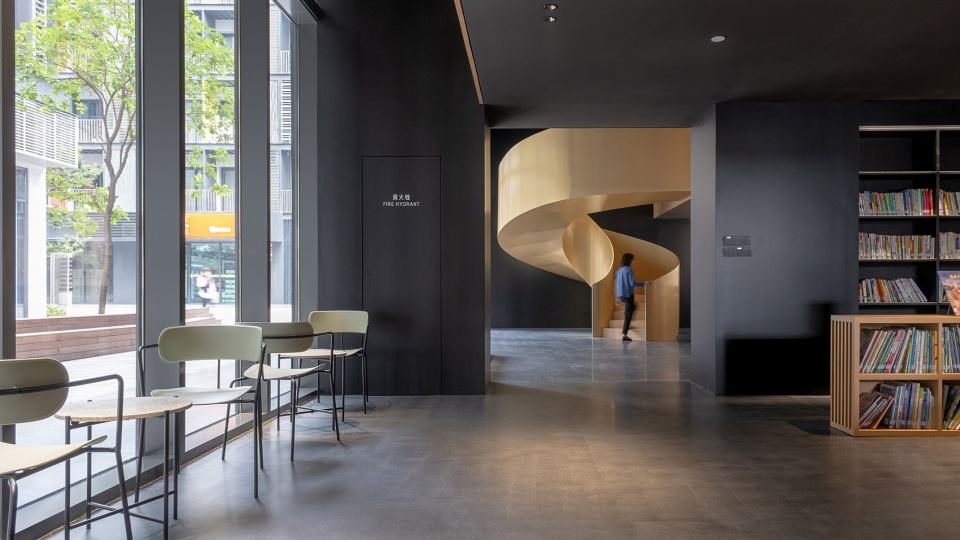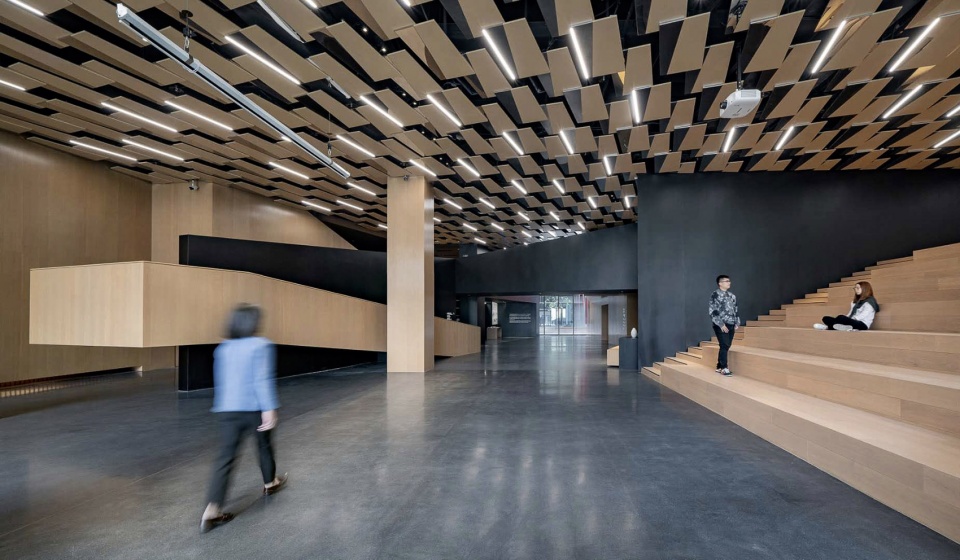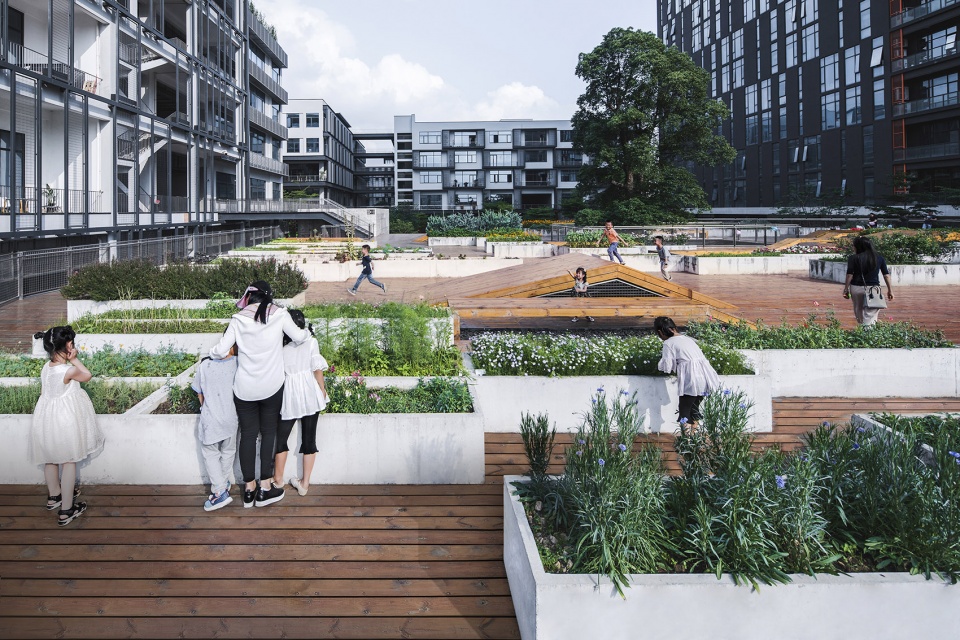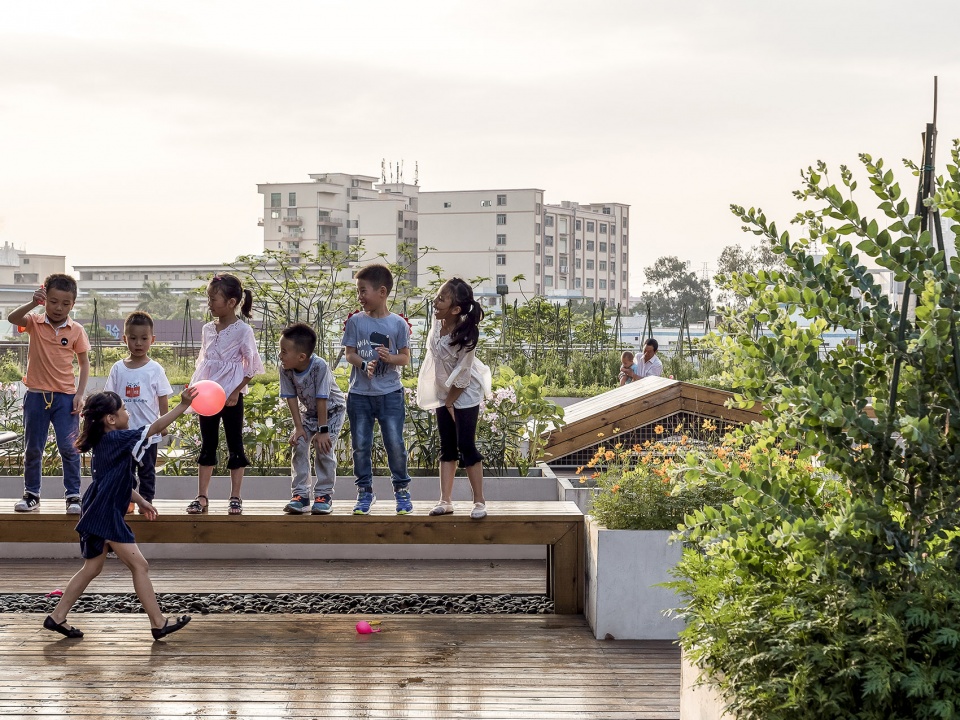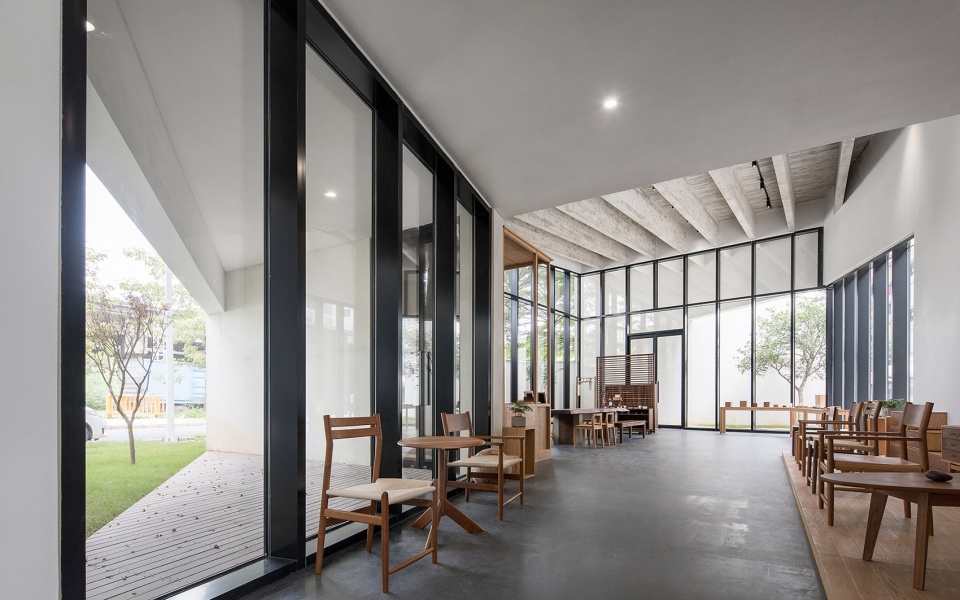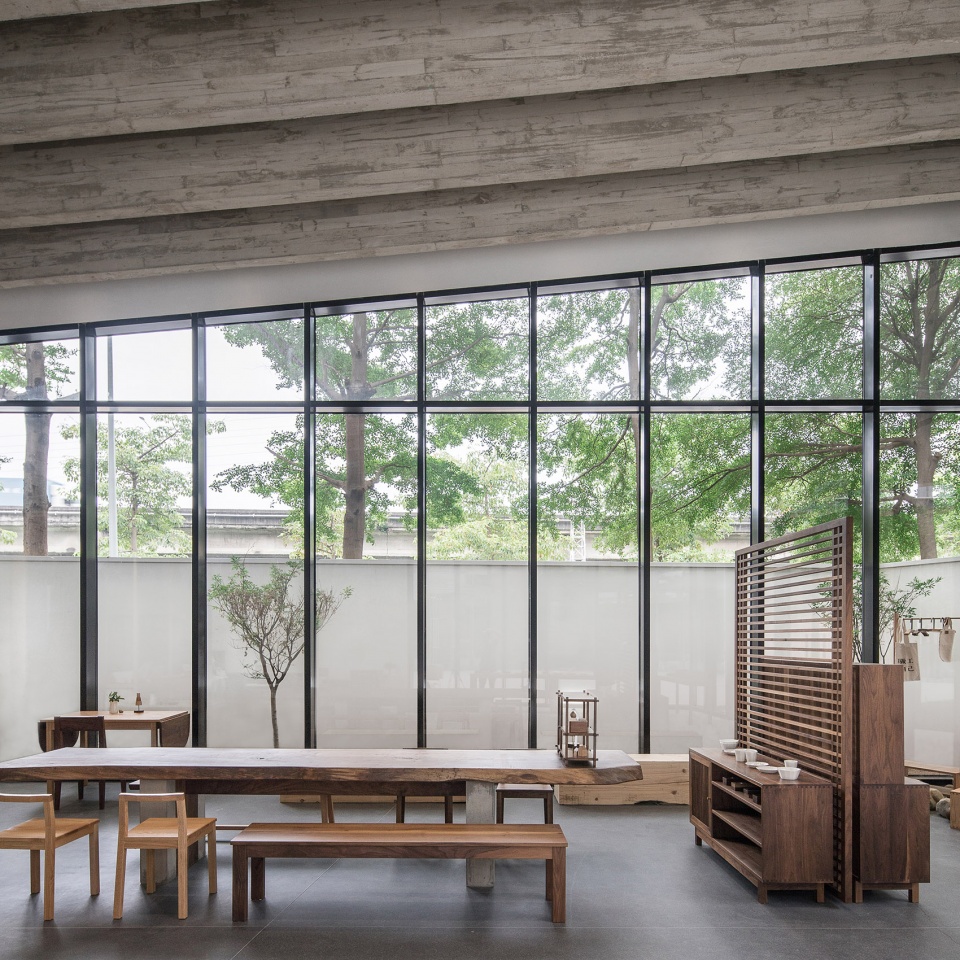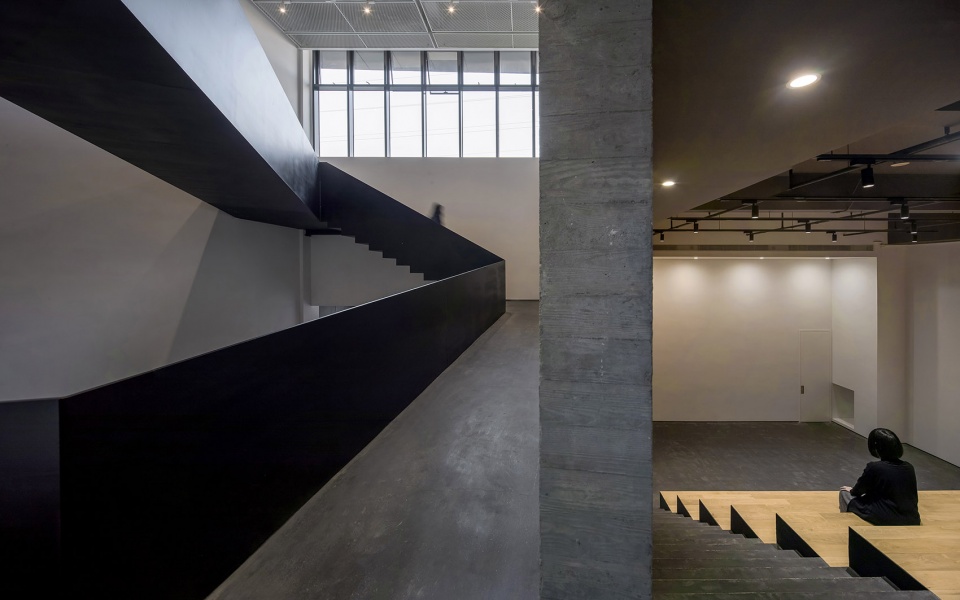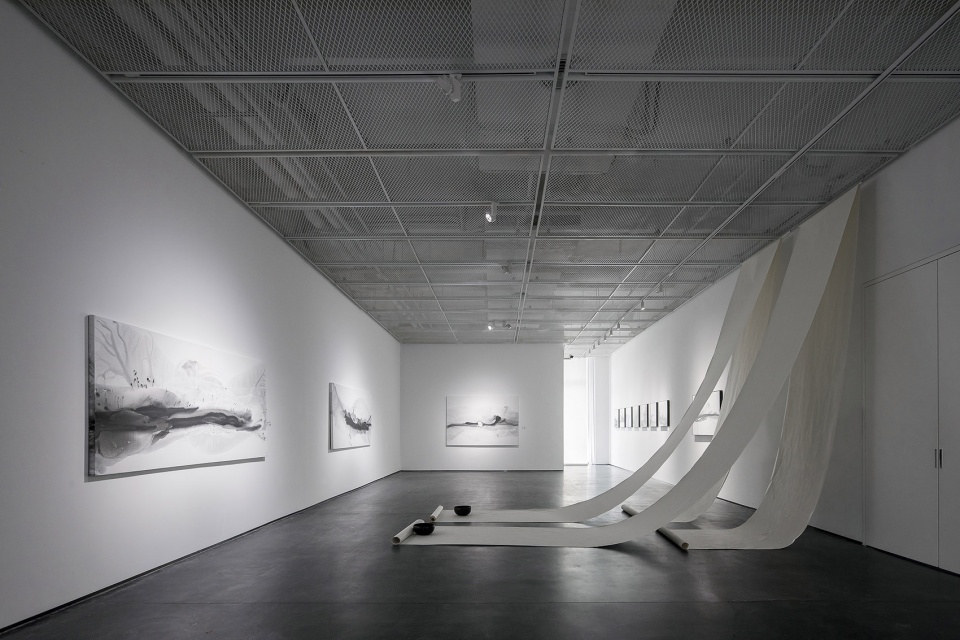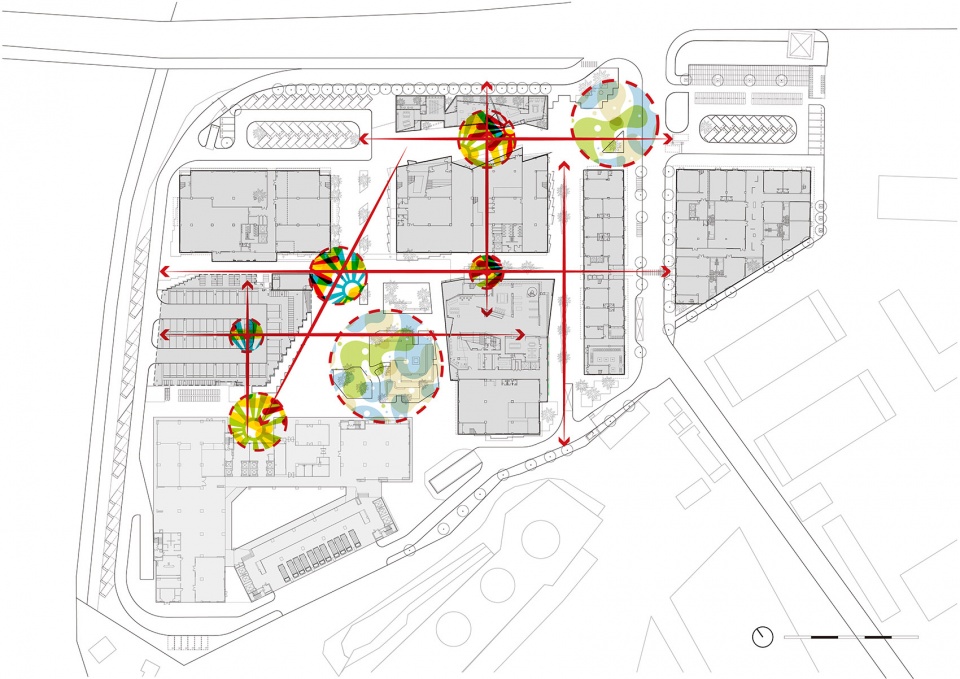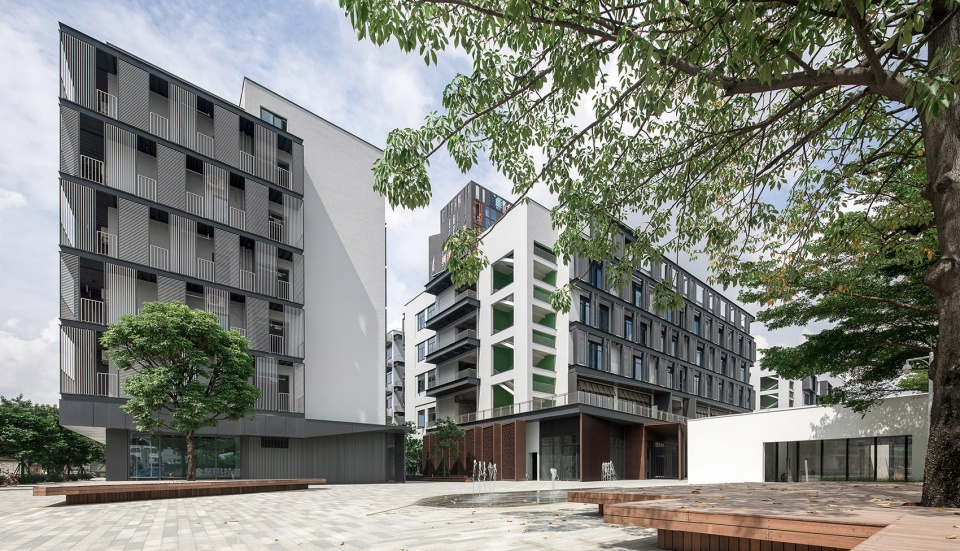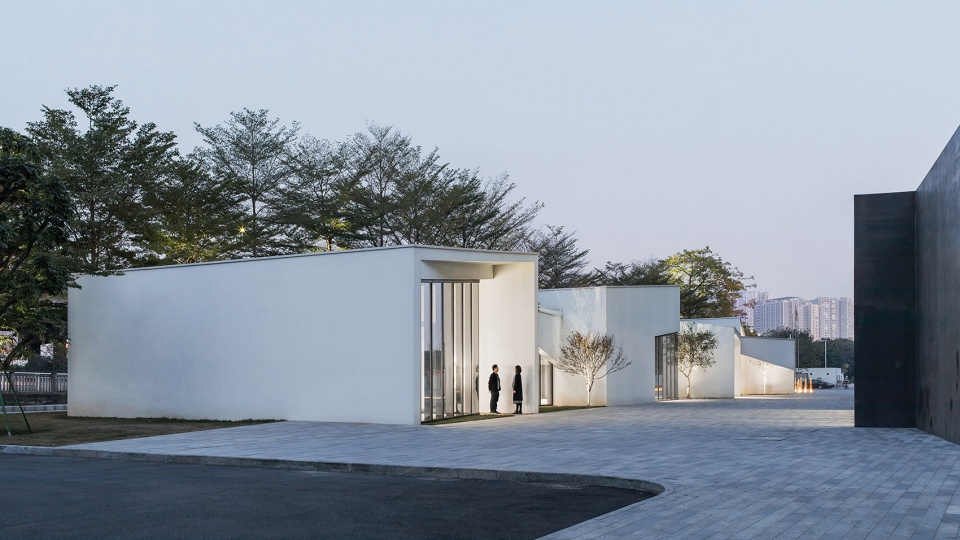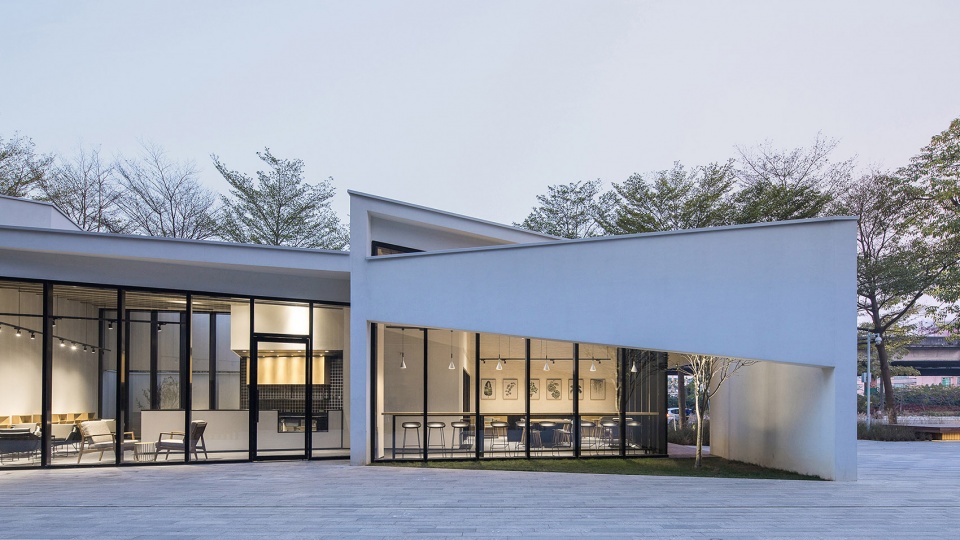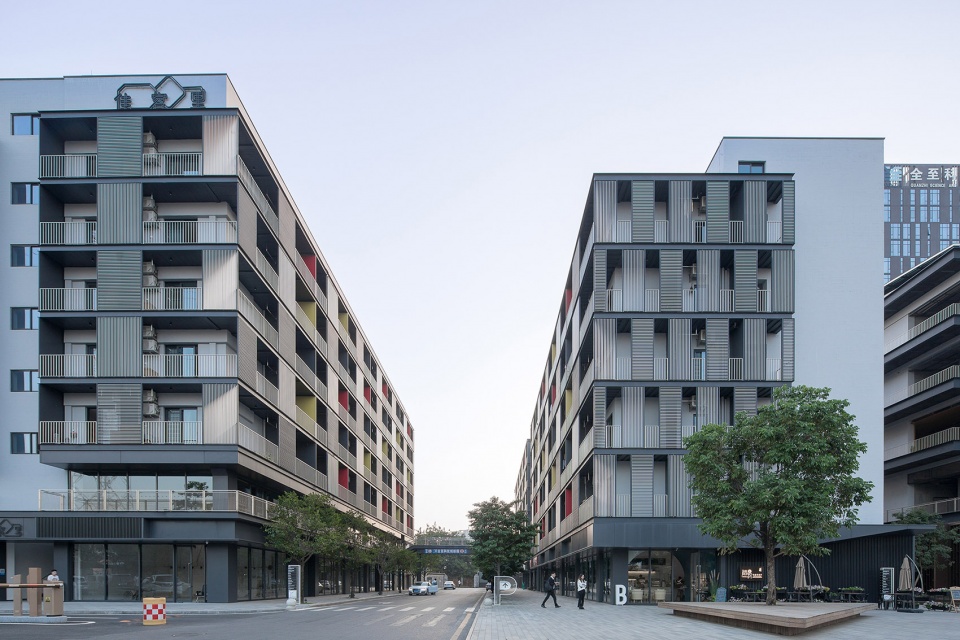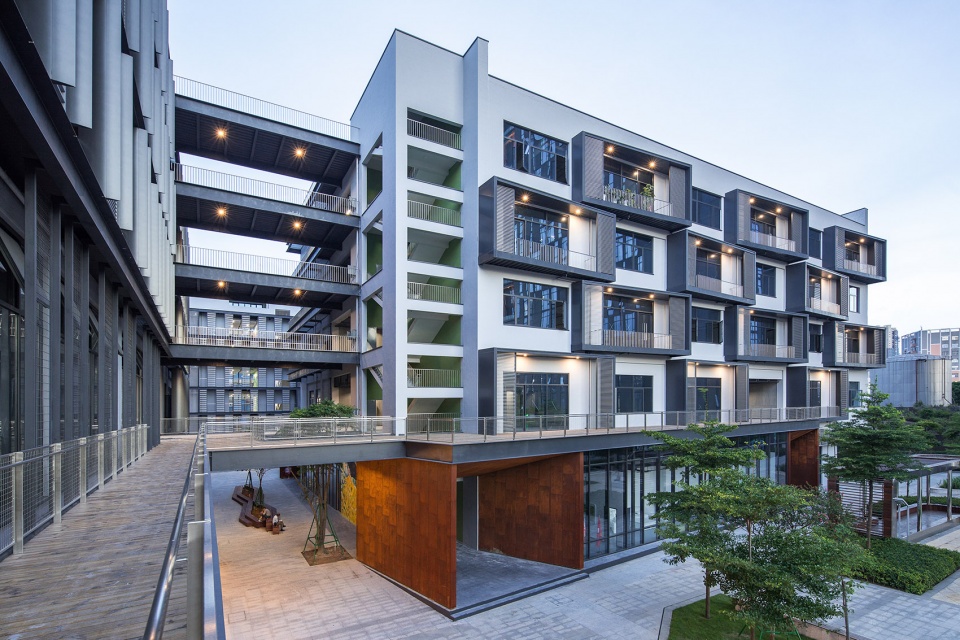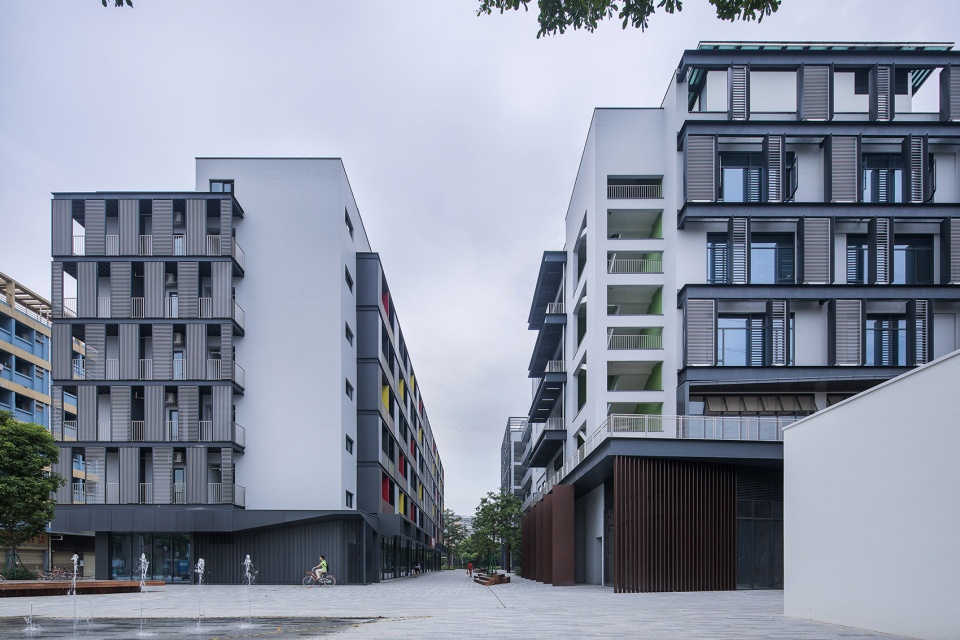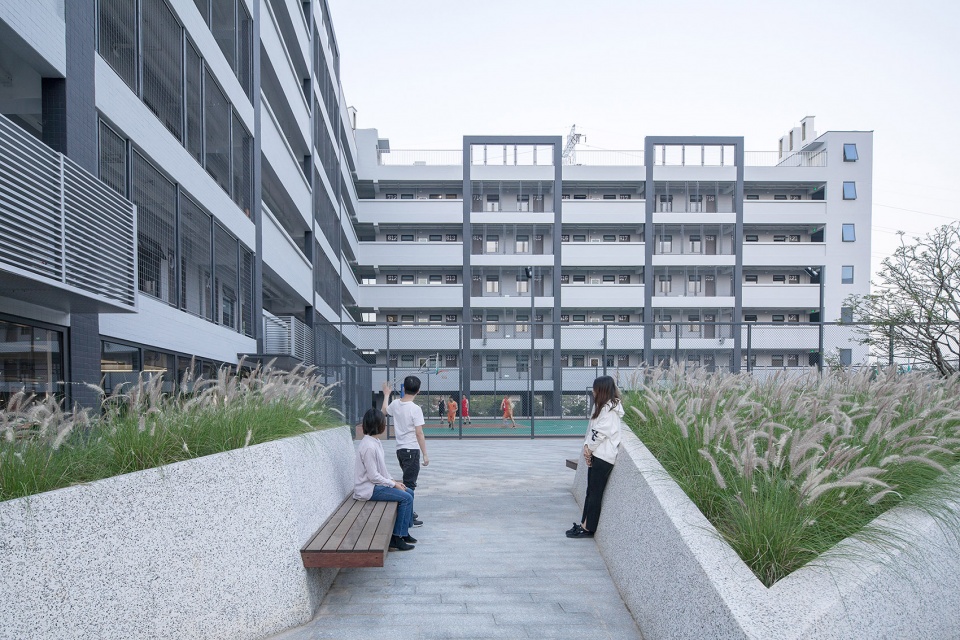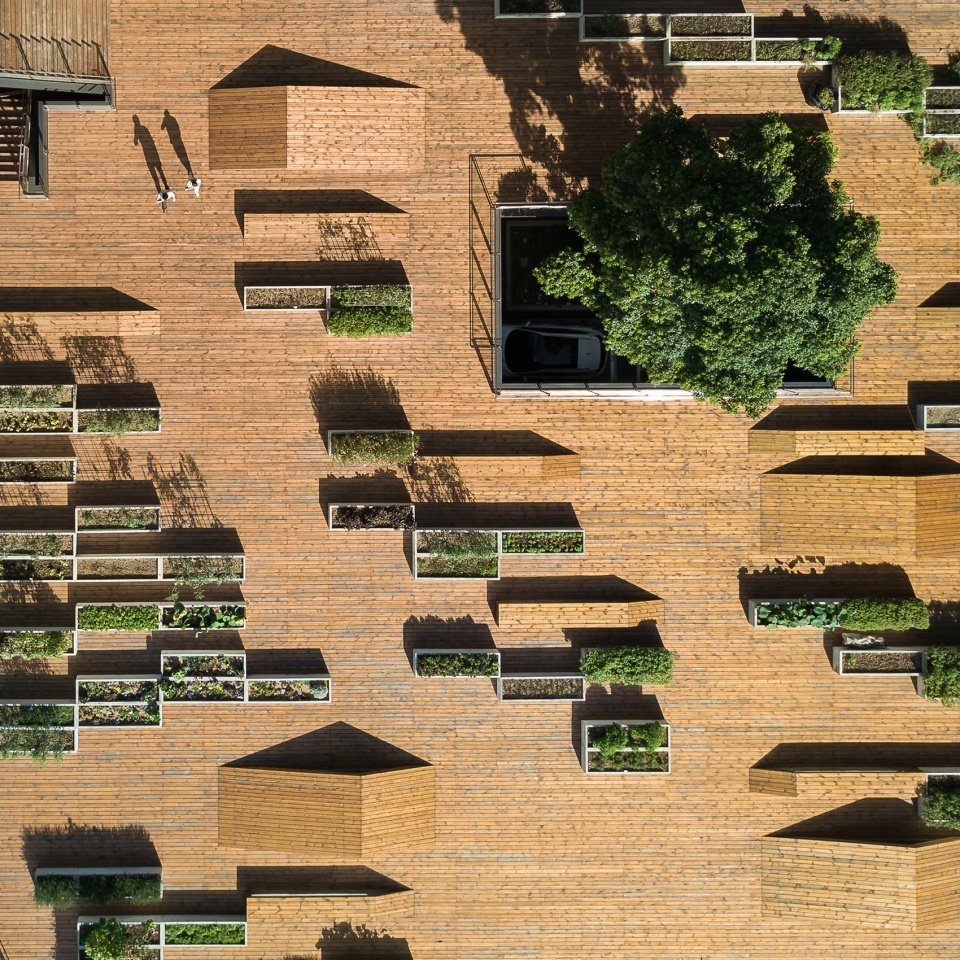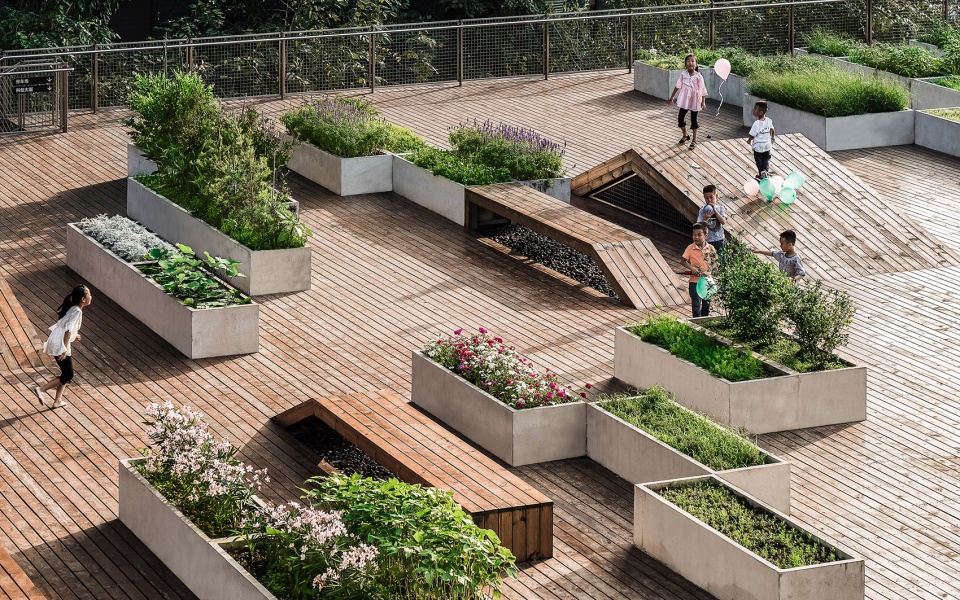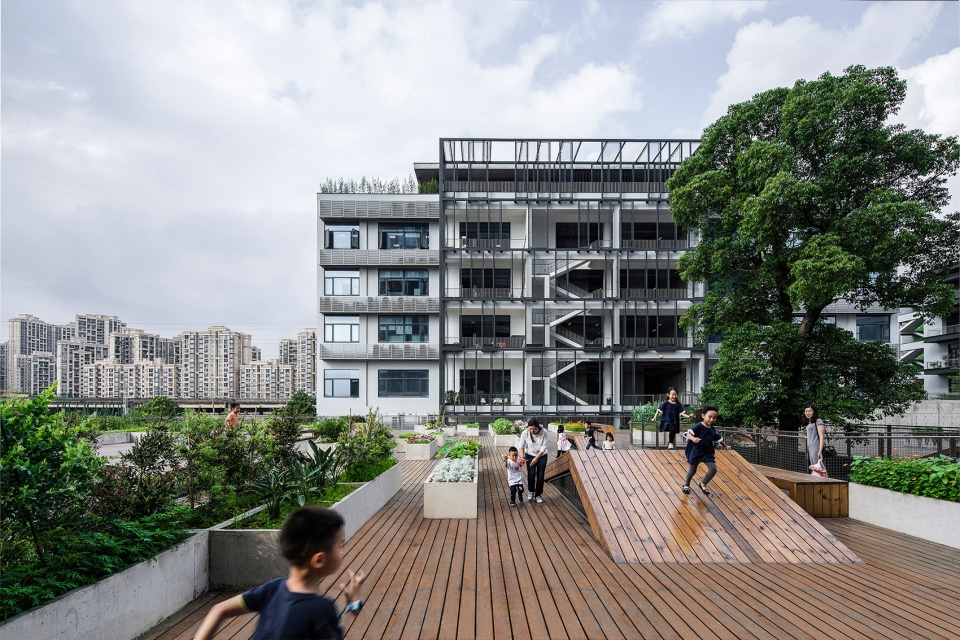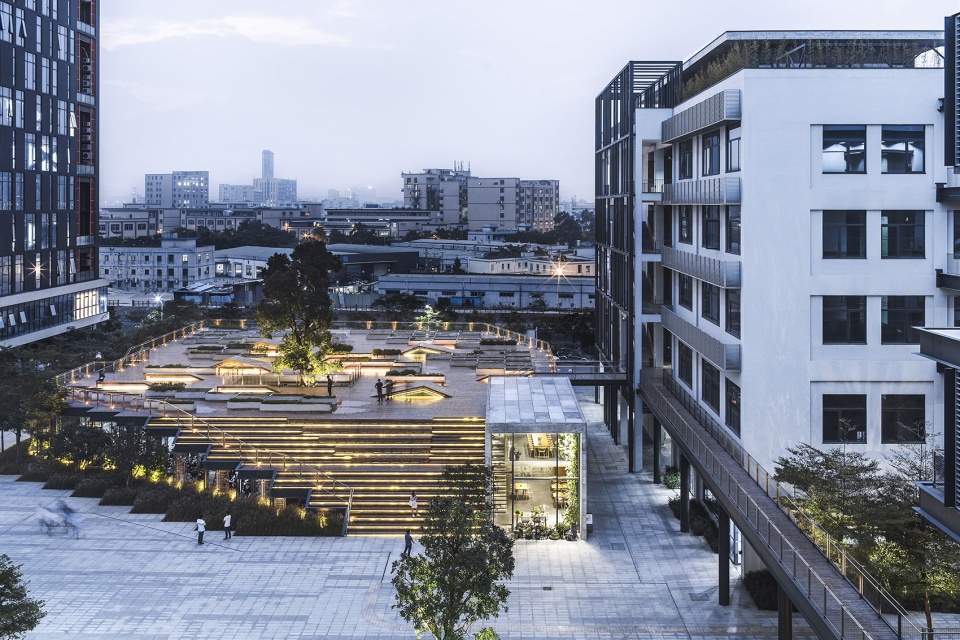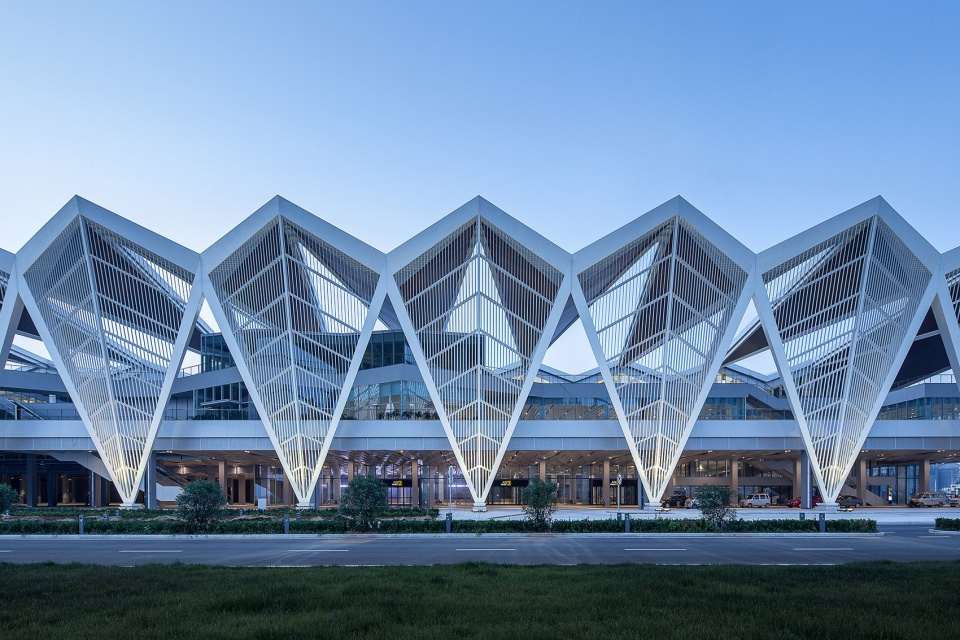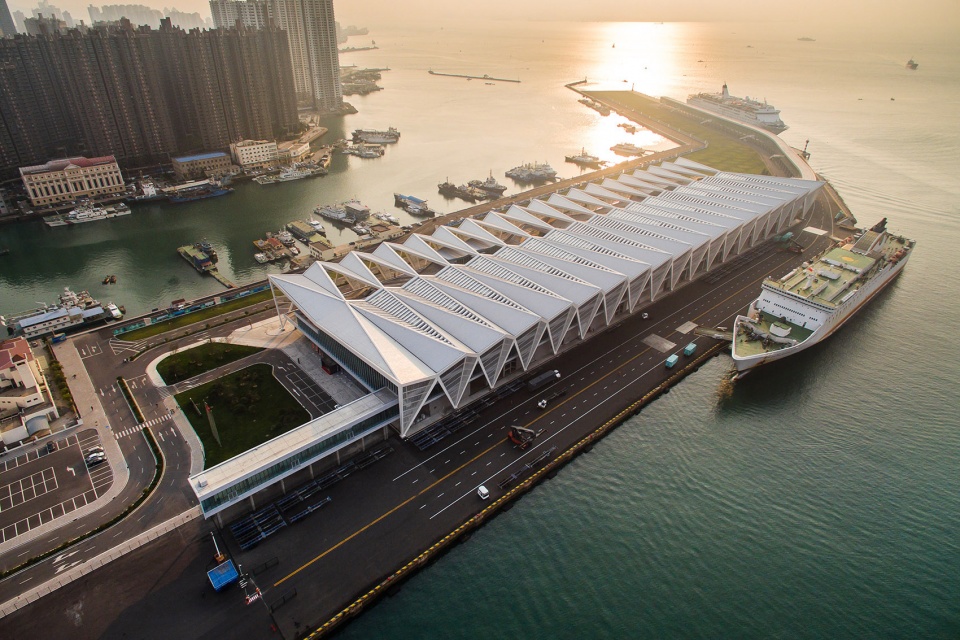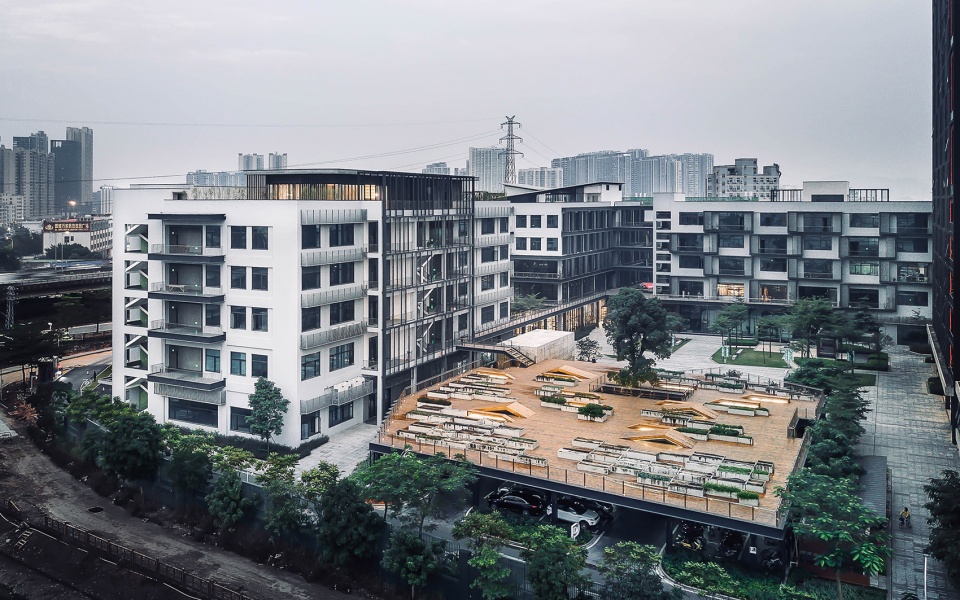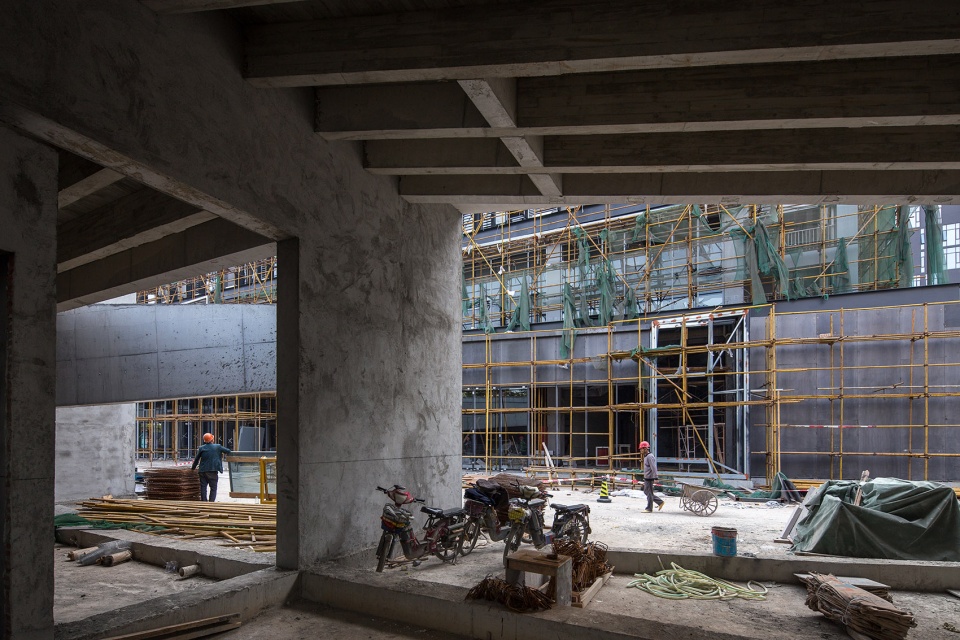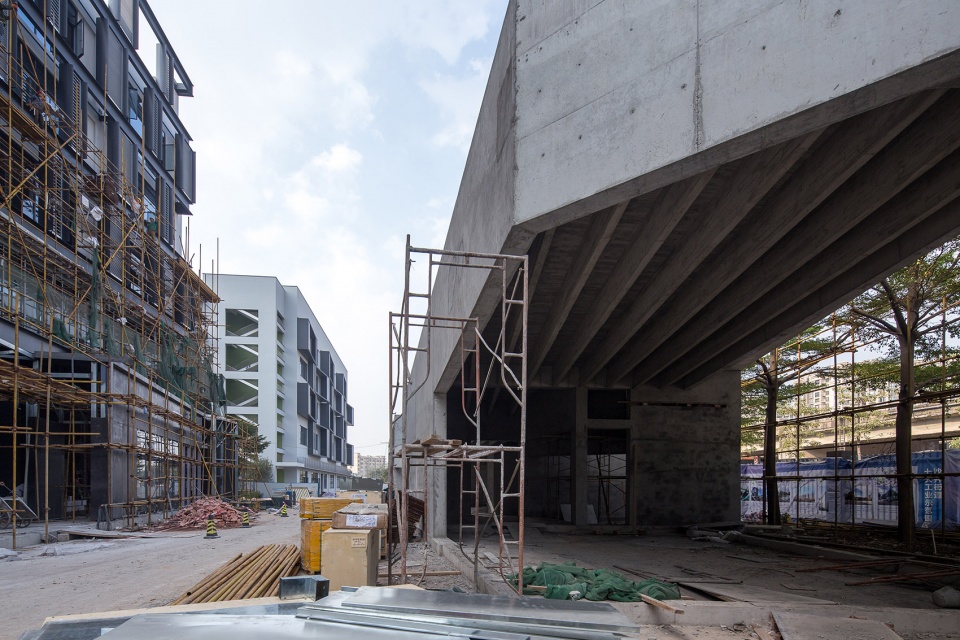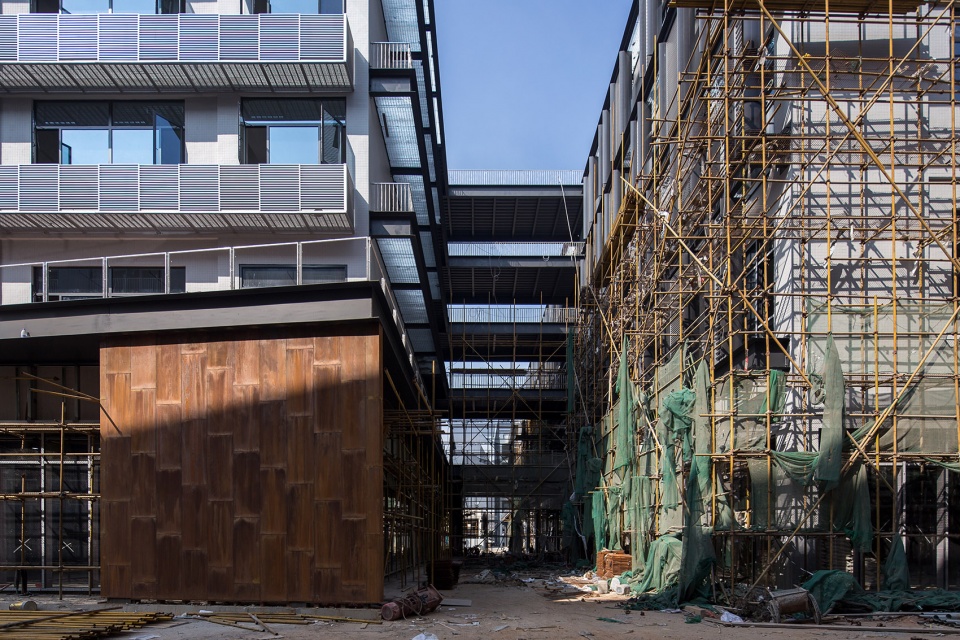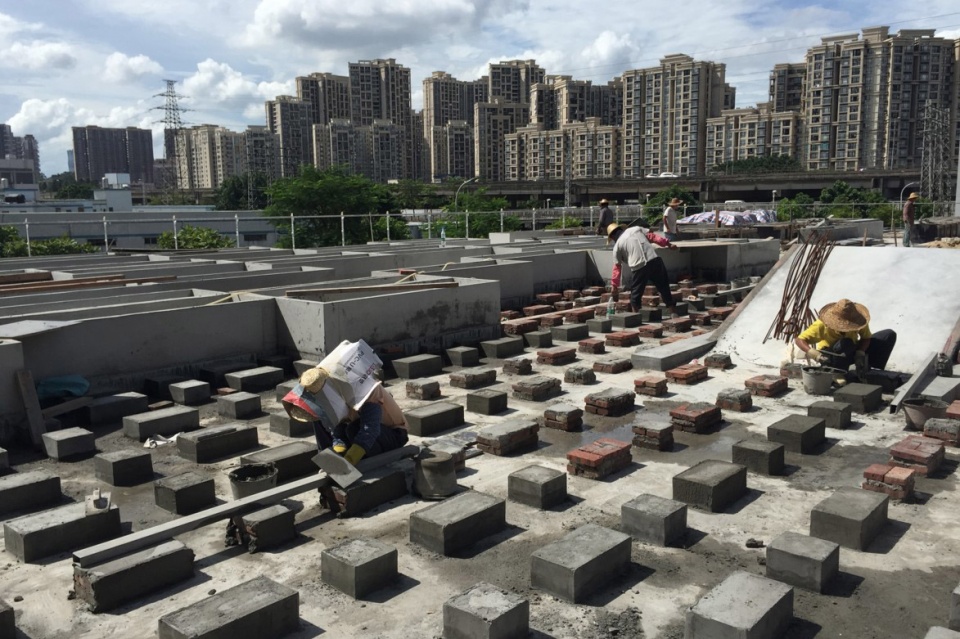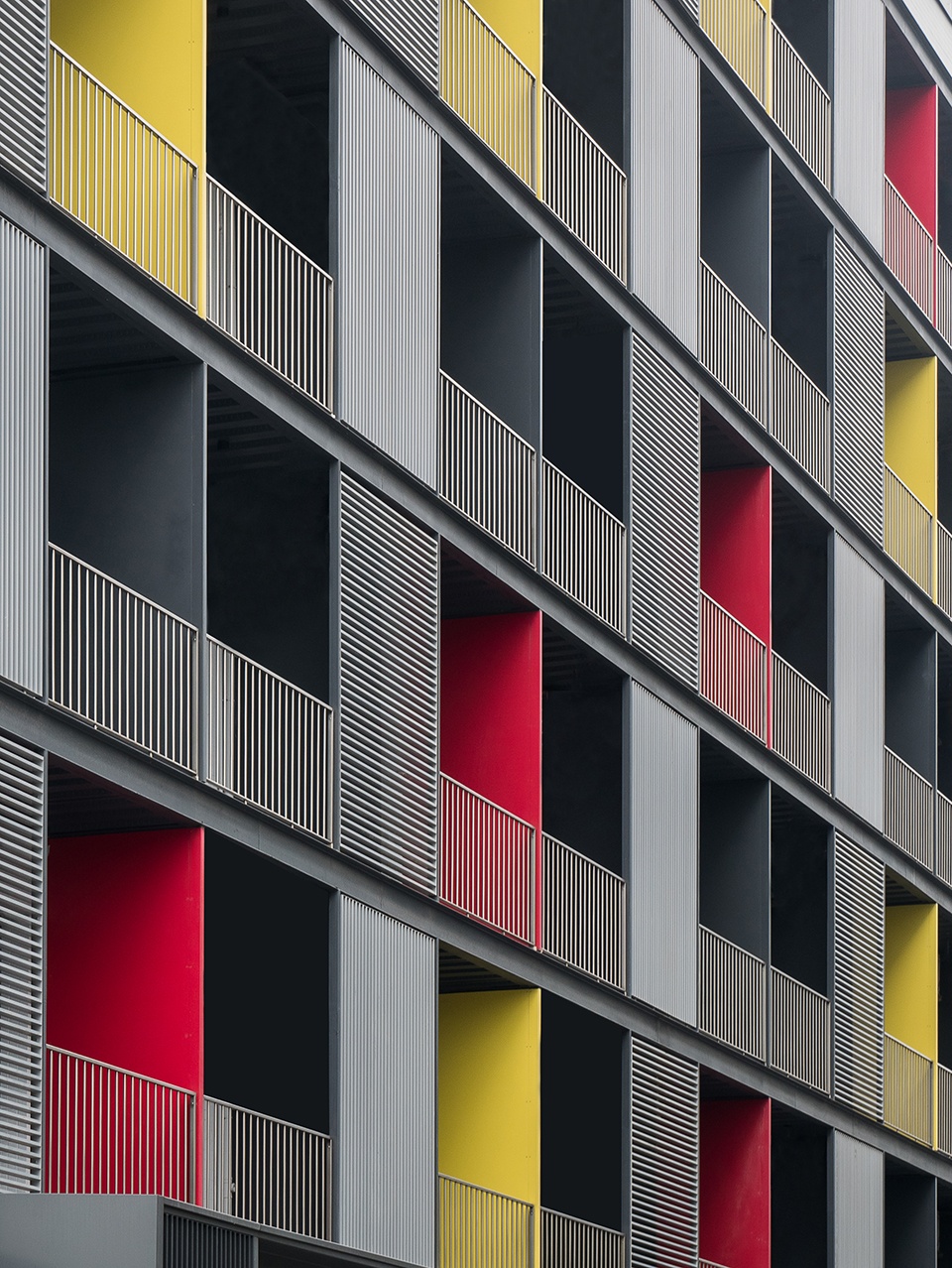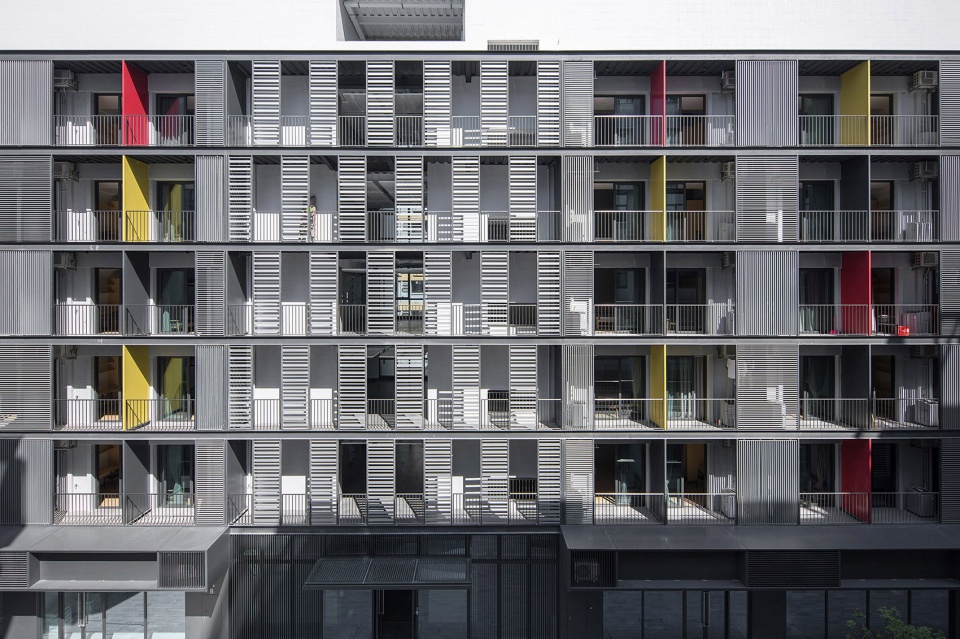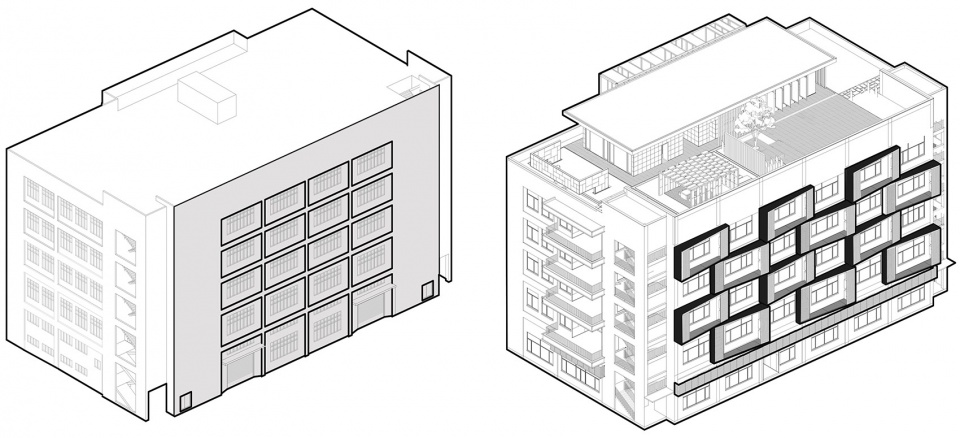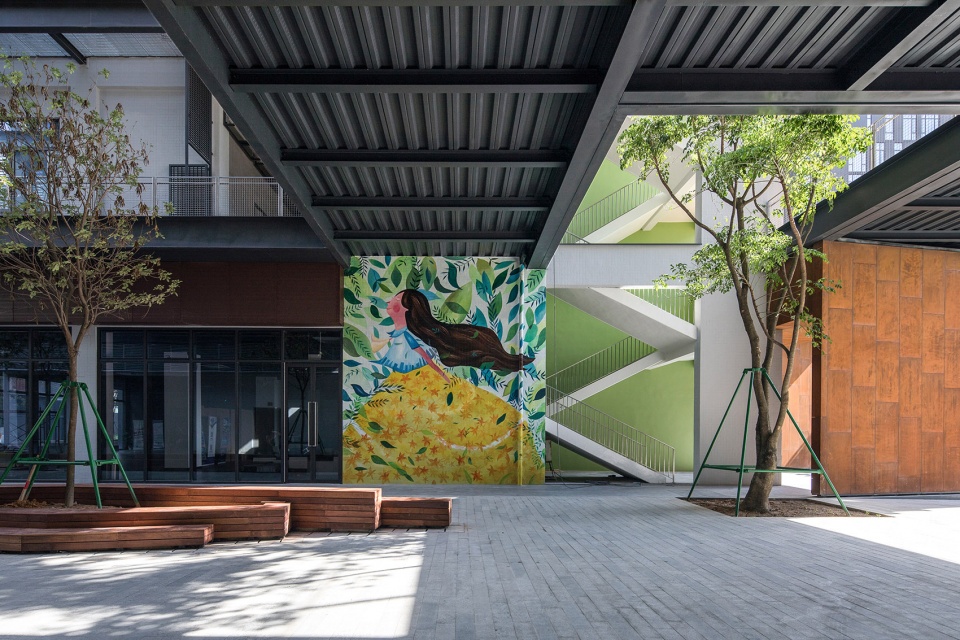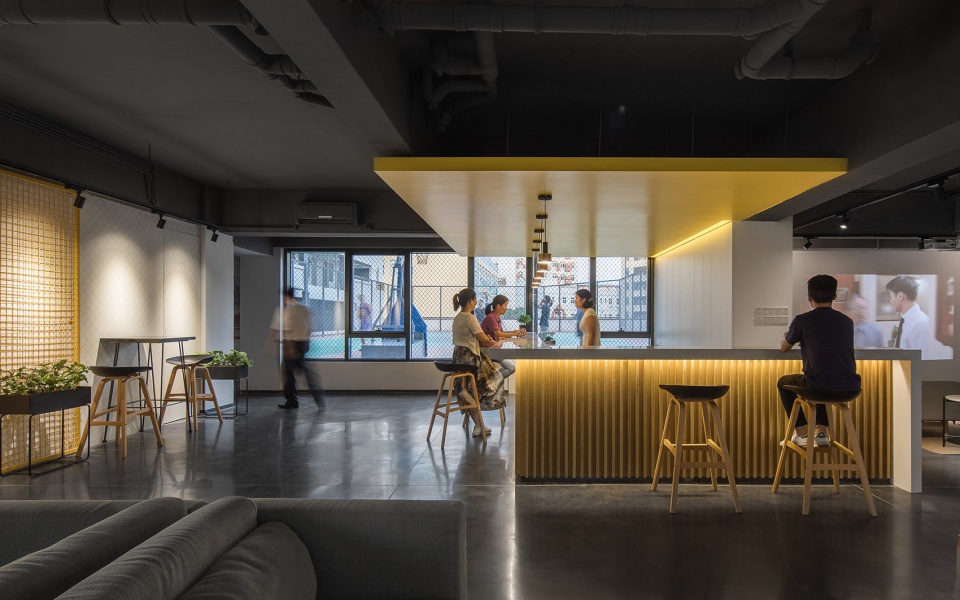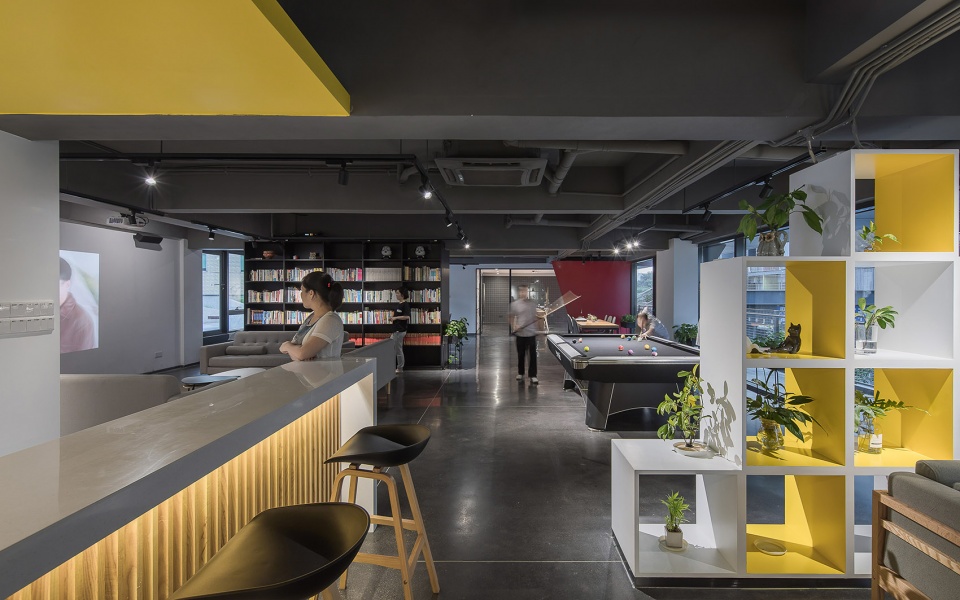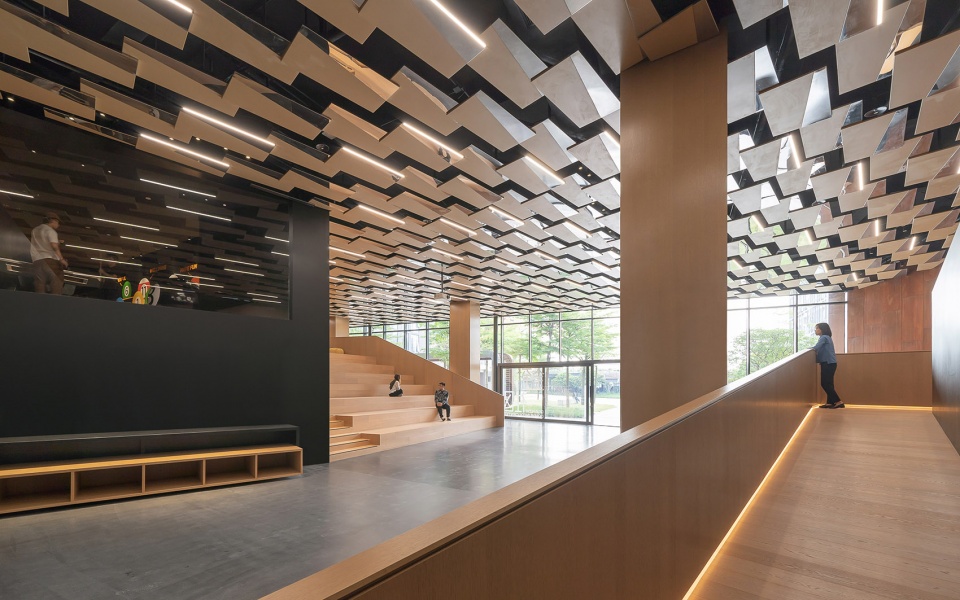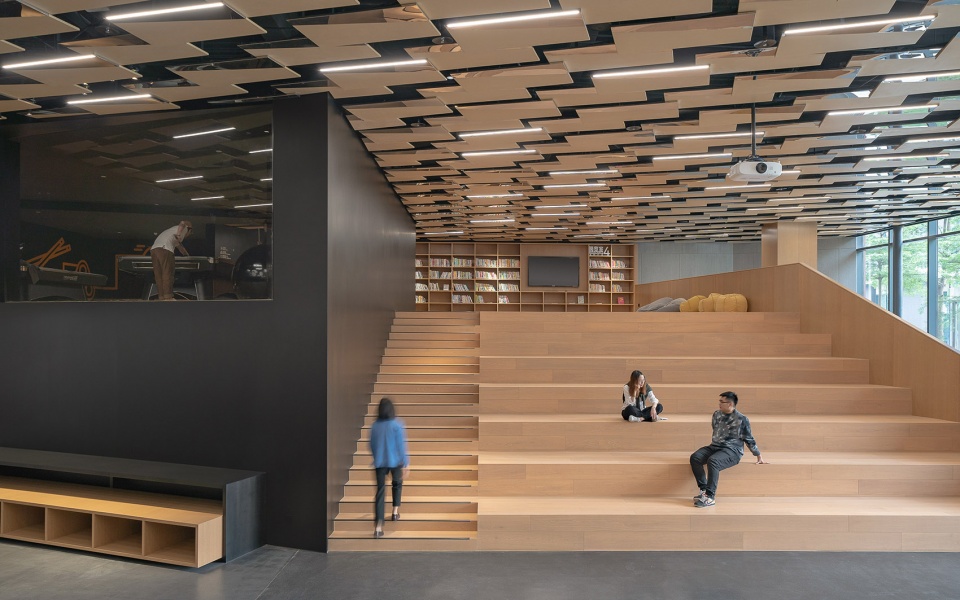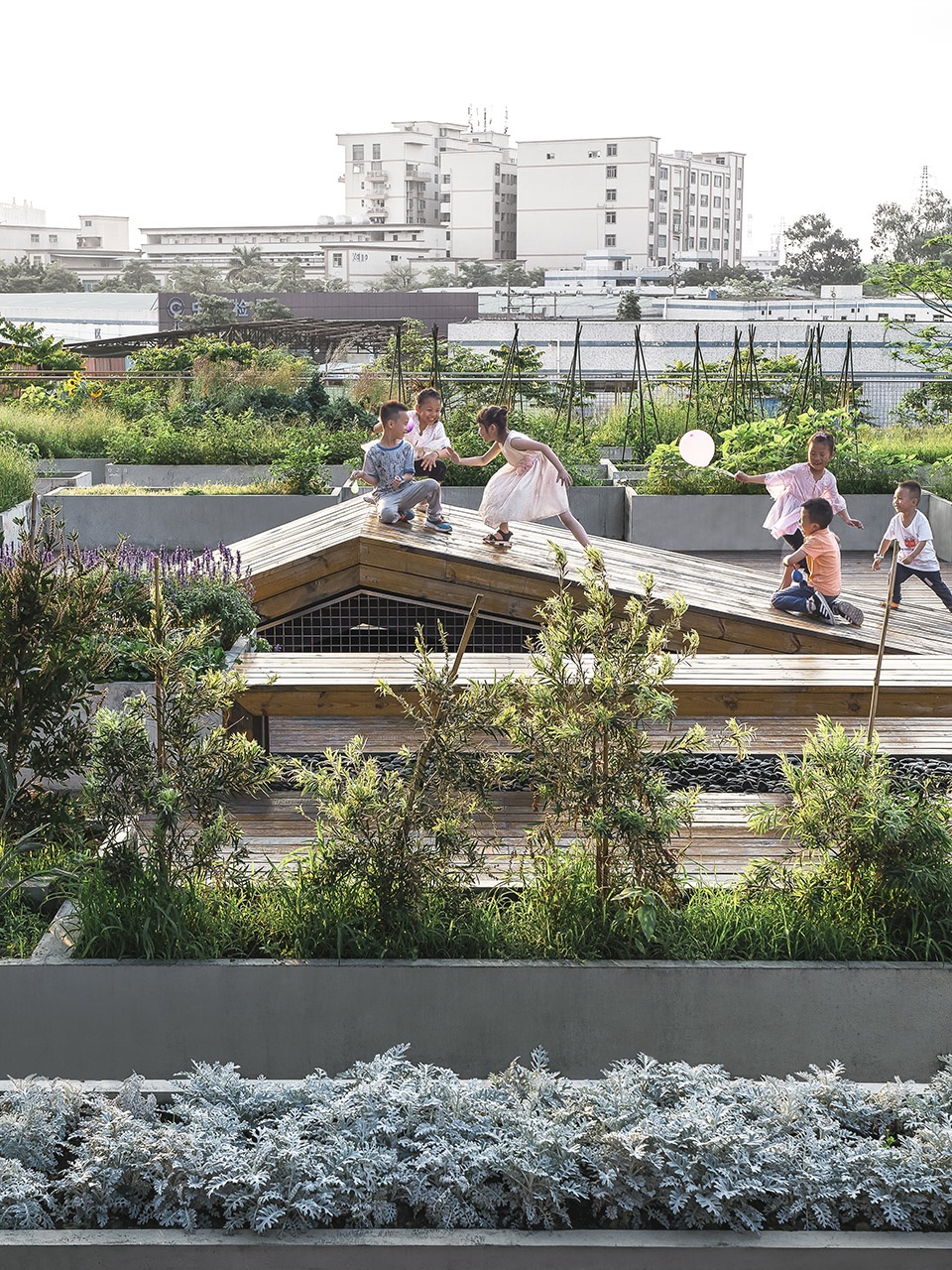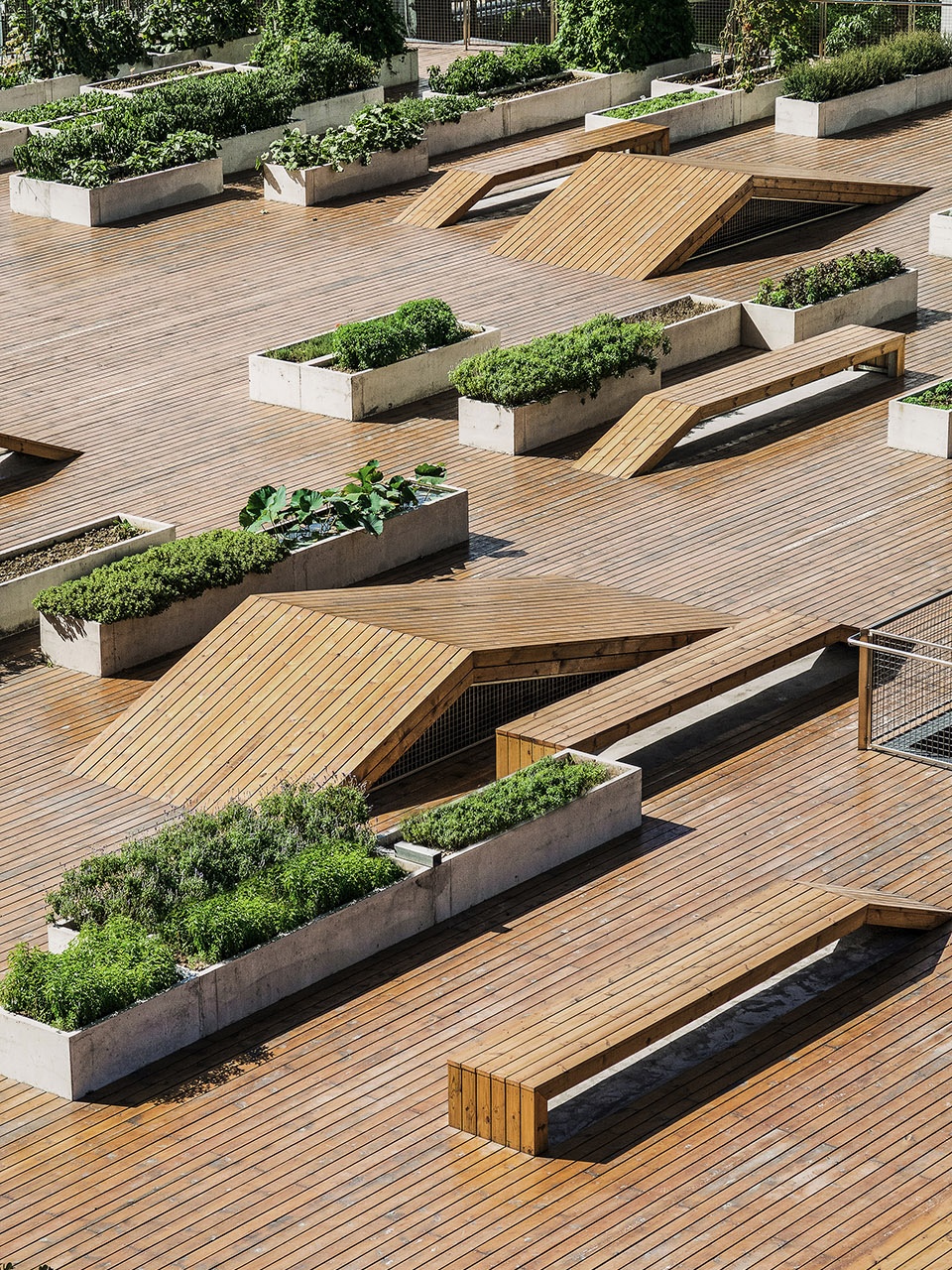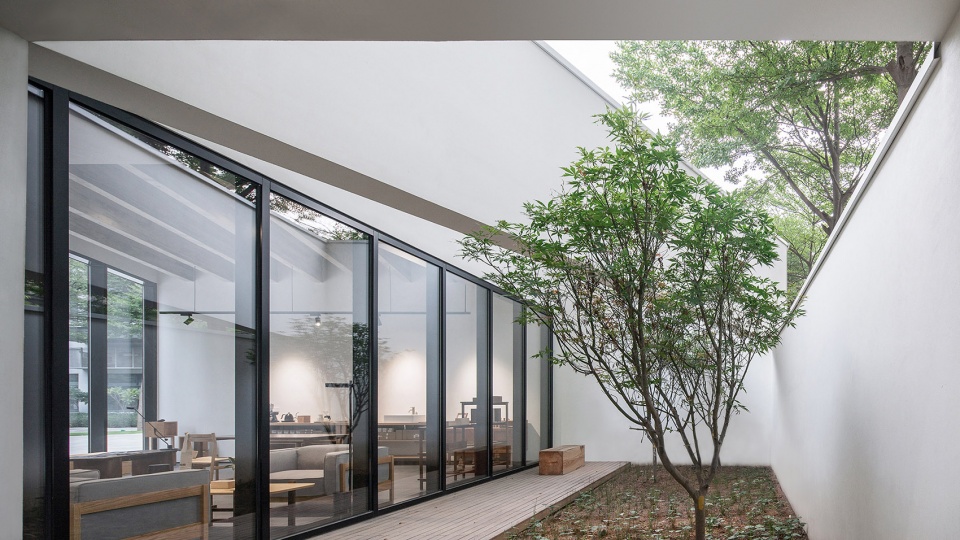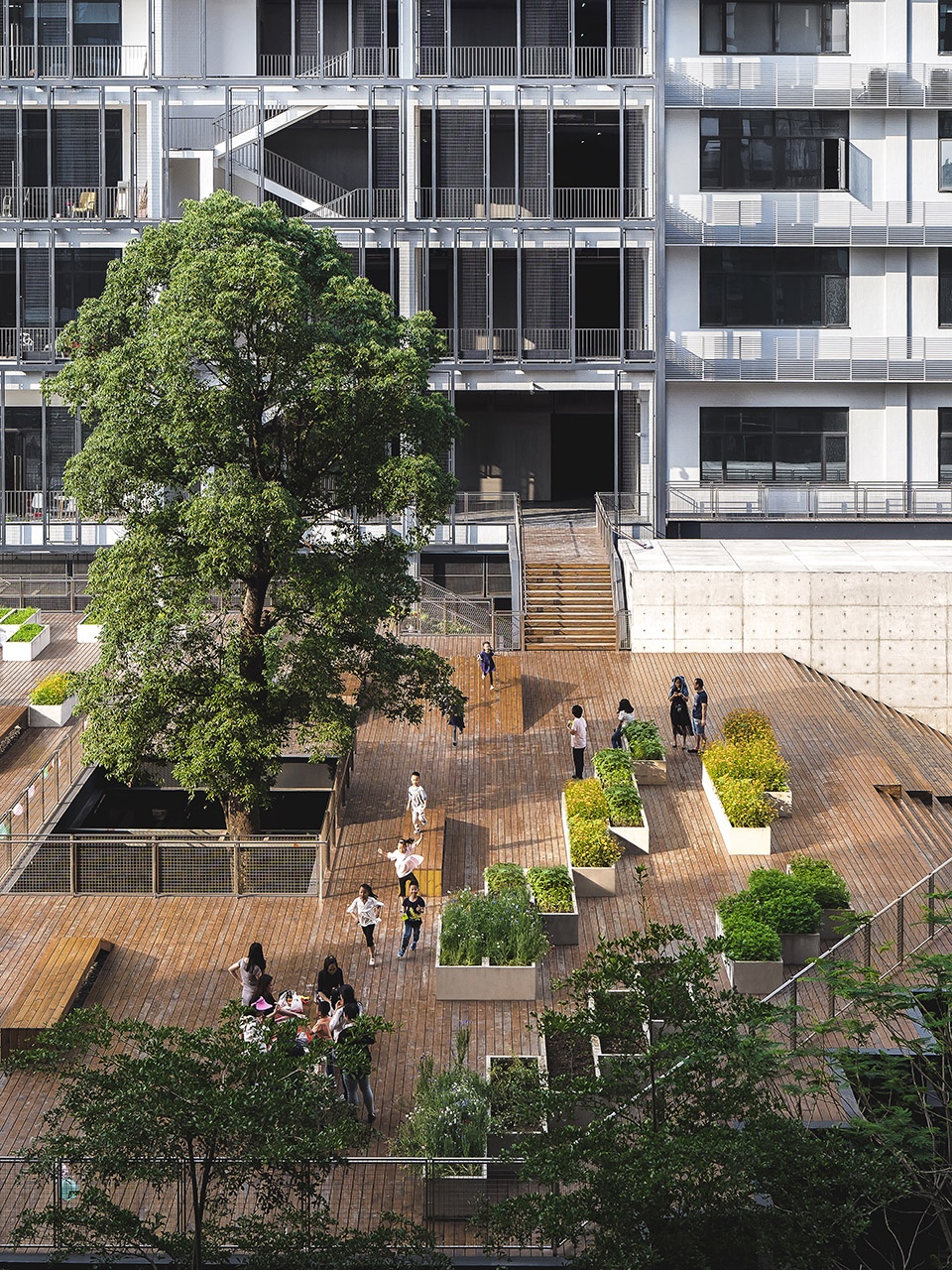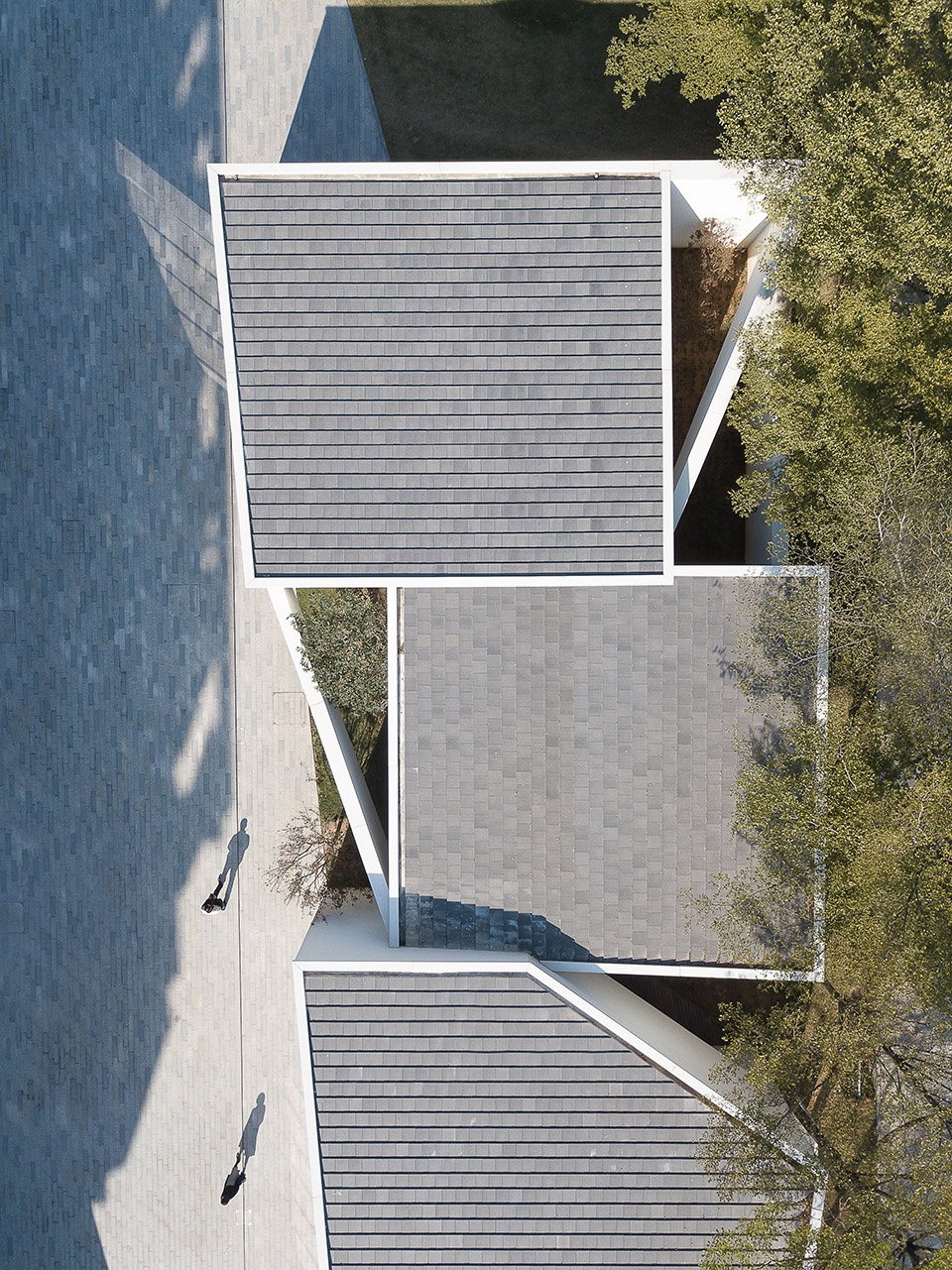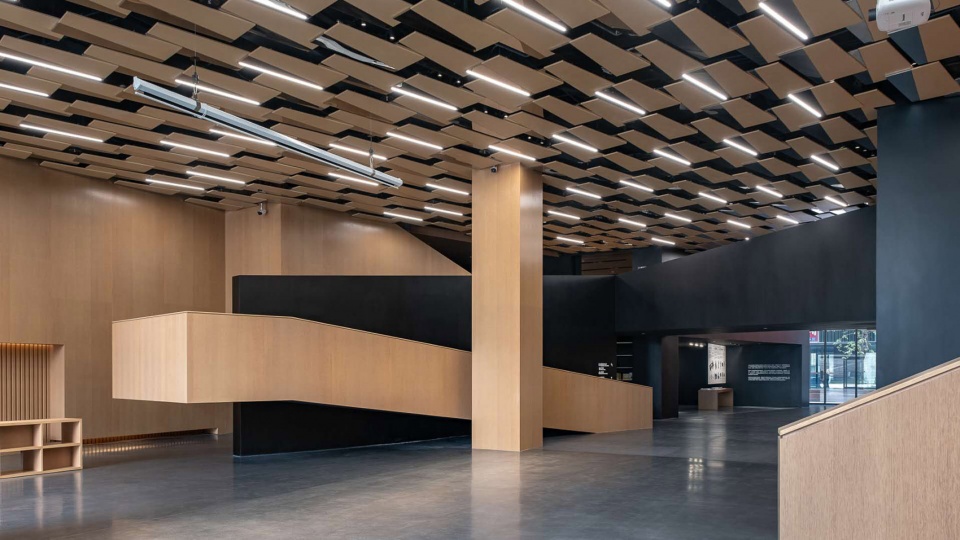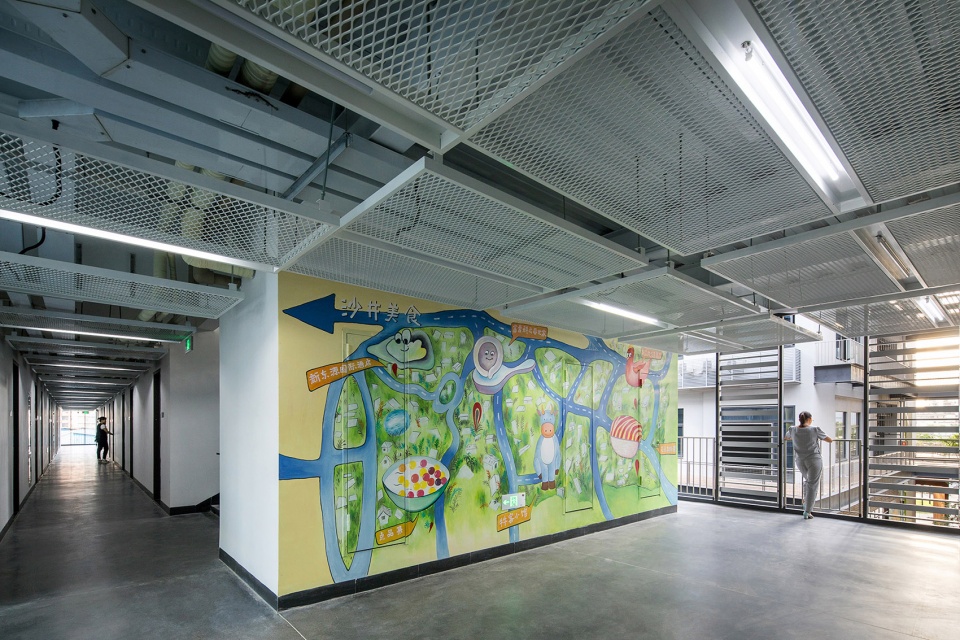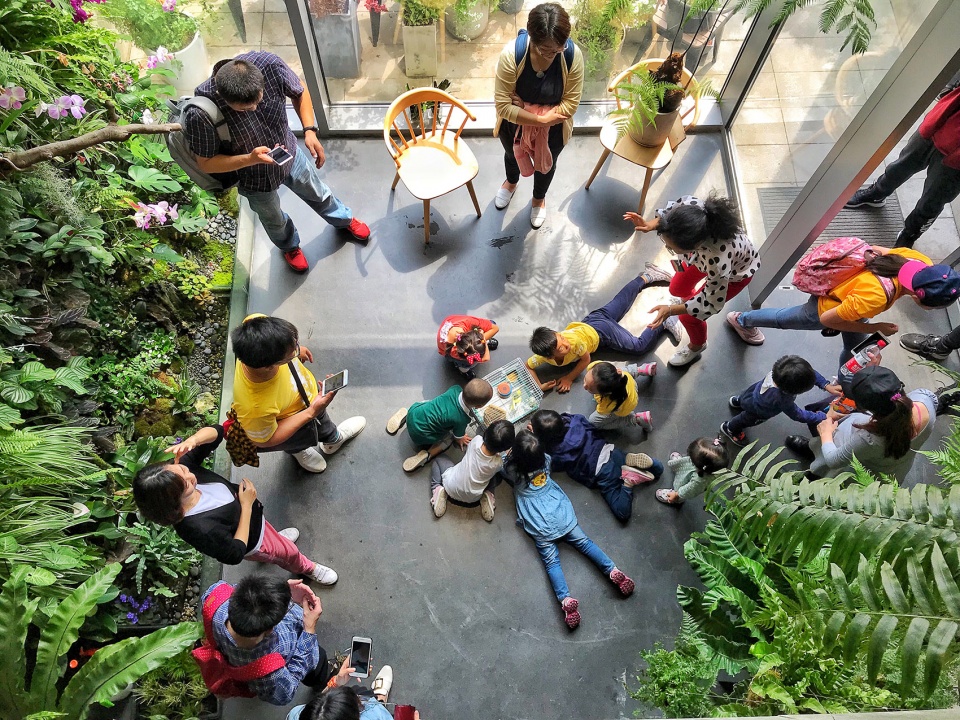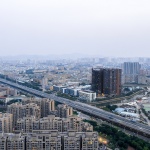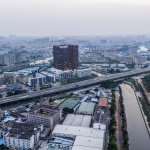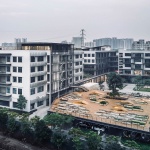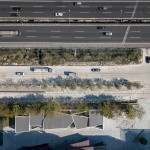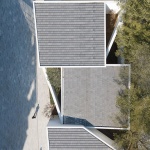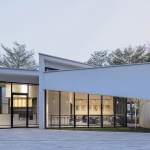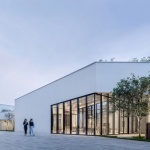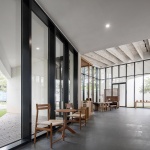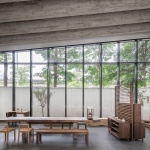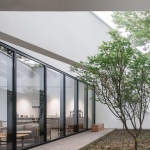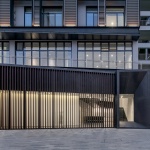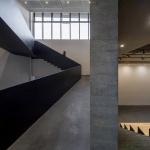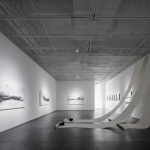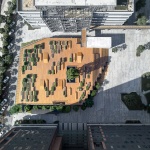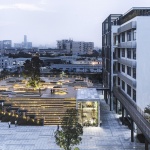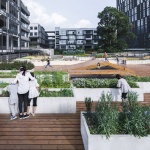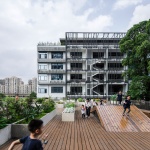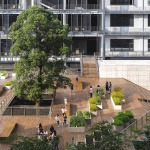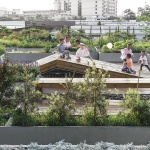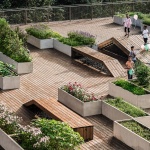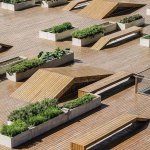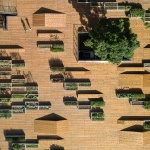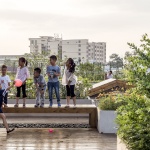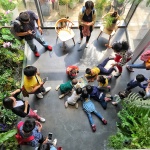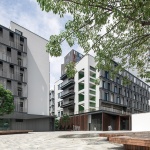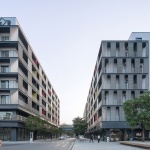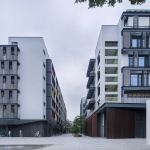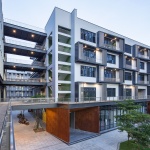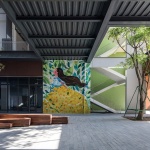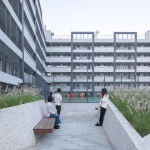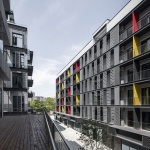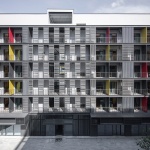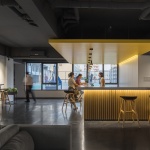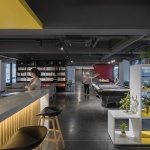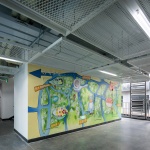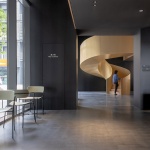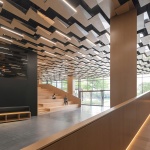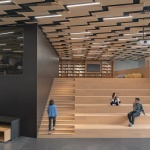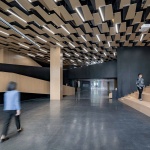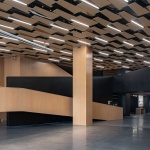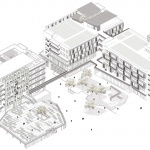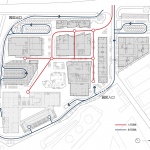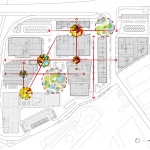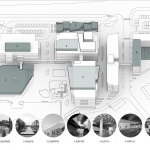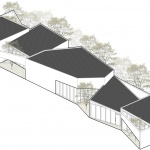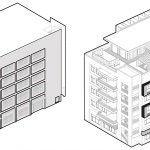gooood对一些机会和条件合适的项目推出深度报道,希望对项目进行更为立体的表达和展现。本次专辑带来的是 墨照建筑设计事务所 设计的全至科技创新园改造项目的独家专访。更多关于他们,请至:MOZHAO ARCHITECTS on gooood
gooood would dig into projects which are appropriate for deeper report, in order to present the project in a more comprehensive way. In this episode, we interviewed MOZHAO ARCHITECTS for their Quanzhi Technology Innovation Park Renovation project. More: MOZHAO ARCHITECTS on gooood
出品人:向玲 | Producer: Xiang Ling
编辑:陈诺嘉,武晨曦,李诗蓉 | Editor: Chen Nuojia, Wu Chenxi, Li Shirong
点击查看科技园中的改造项目:佳客里公寓,至美术馆,种植平台和体验馆,生活美学馆
Click to see the renovation projects in the technology park: Jiakeli Apartment, Zhi Art Museum, The Planting Terrace and Experience Pavilion, Living Art Pavilion
▼科技园远景鸟瞰,distanced aerial view of the park
墨照建筑问答
Q&A with MOZHAO ARCHITECTS
(Please scroll down to see the English version)
_____________
项目背景与改造策略
Background and Strategy
“愉悦的步行体验让公共功能、自然和人之间建立更紧密的关系。”
1. 改造的初衷是什么?园区在沙井街道乃至城市中的定位是怎样的?园区的主要使用者是谁?其改造需要满足怎样的社会和市场需求?
全至科技创新园位于深圳宝安区沙井街道的北部。借助地理优势和便捷的交通路网,沙井从二十世纪八十年代中至二十一世纪一十年代初蓬勃发展了低端制造产业。随着经济产业的发展,沙井从乡村面貌逐渐变成遍地是工厂和农民房的城市空间。大量工厂的建设吞噬原有优美的湿地和农田。这些低端制造产业衍生的工业园区粗暴迅猛地在城市边缘无序扩张。无论是工业园区内部,还是园区的外部城市空间都形成单一和消极的场所。人性化的诉求让位于高效的生产方式和最大化的资本逐利。厂房及宿舍也只是廉价的并且能快速建造的 “豆腐块”形式的建筑类型。除了物理环境变化之外,经济快速发展也影响着沙井人的生活方式和传统习俗和观念。新的居住空间、商业空间和城市公共空间缺少对城市肌理脉络和传统文化生活的梳理与回应。此外,国家的产业升级政策宣告进入后工业时代,成本上升迫使低端产业外迁,老工业园区需通过升级改造来满足新的社会和市场需求。全至科技创新园则是在这时代背景下生成的典型工业园区。设计的改造范围是三栋总建筑面积为三万平米的厂房和三栋总建筑面积为一万平米的宿舍。通过功能升级,将原厂房生产车间改造成研发智造空间,而宿舍改造成公寓。改造的初衷是在保留未拆除建筑的前提条件下,改善提升原有建筑空间和环境品质,并创造积极的城市公共空间和人性化场所。同时,设计希望通过绿色人文空间的重塑,营造与沙井当地相融合的建筑空间和社区氛围。改造后的全至科技创新园是一个开放的园区,除了面向园区内工作的人,园区也希望成为沙井乃至城市中有特色和吸引力的休闲生活场所。
▼项目鸟瞰,位于城市边缘的工业园区,aerial view of the project located in the industrial park at the edge of the city
▼沙井城市化卫星图,urbanization of Shajing
2. 改造后园区的车行流线设计是一大亮点,为什么采取了这样的设计策略?
改造前的园区和大多数工业园一样,人车混行,车道与人行界限模糊。对于这个用地面积不大的项目,常规的总图流线组织会采取单一园区出入口以及车行与停车空间围绕中心庭院展开布置。在设计之初的场地研究中发现,园区的布局不乏一些尺度舒适的空间:比如宿舍与厂房之间的通道、园区中心的大庭院和园区北侧一排的小叶榄仁树。另外,园区的西侧和南侧被茅洲河围绕,北侧是高架高速公路,园区因此成为一个末端角落的场地区域。于是我们大胆提出利用城市道路来实现单车道单向循环的车行流线。园区的入口设在场地东南角,而出口则在西北角。车行方向按顺时针方向设计。连接西北出口和东南入口的是两条次级城市支路。因为外部车行很少,并不影响车行循环的效率。这样的车行流线策略极大的释放了公共空间和步行空间:园区的东北角形成了一个城市广场作为园区主入口,人可以选择步行在宿舍与厂方之间的通道或者沿着北侧的一排小叶榄仁下的生活美学馆步行到园区中心的大庭院。整个步行过程是无车环境,而且与绿树、烘培店、茶饮店、美术馆、家具店、食堂、社区中心等公共功能发生联系,最后连接到每个建筑的电梯厅。愉悦的步行体验给予园区上班的人舒心的上班与下班过程,也让公共功能、自然和人之间建立更紧密的关系。
▼改造前流线分析,circulation analysis before renovation
▼改造后流线分析,circulation analysis after renovation
“公共功能位置的确定关系着园区公共空间系统如何串联,也成为往后的每个公共功能建筑的设计条件和场所条件。”
3. 全至科技创新园的改造中除了厂房升级为办公以及宿舍升级为公寓之外,引入了许多公共功能,包括生活美学馆、至美术馆、种植平台与体验馆、会馆和社区中心等等,请简单介绍一下这些公共功能的选择和设计的经过,以及它们在园区中各自的地位和相互之间的关系。
这个项目甲方给予我们很大的信任与自由度。甲方一开始的功能诉求只是希望增加一个美术馆来推动园区的文化艺术氛围,另外还有一个企业会所来满足企业的公司活动需求。并且对于这两个功能的面积及所在位置,都没有限定死。于是,我们有了充分的灵活度去畅想园区改造的整个公共空间及公共功能系统。我们在设计之初的调研中,除了分析之前提及的车行与人行关系之外,大部分的调研分析工作是通过对沙井历史文脉和城市空间的研究,以及后工业时代人文空间的探索,梳理出植入园区的一系列公共功能,以及这些公共功能的大概面积及内部功能组织。更重要的是,这些公共功能位置的确定关系着园区公共空间系统如何串联,也成为往后的每个公共功能建筑的设计条件和场所条件。
▼园区中的公共功能空间,public facilities in the park
例如生活美学馆靠近园区主入口,一方面希望通过新建建筑限定出入口城市广场以及与二号楼之间创造出尺度宜人的步行空间,另一方面,生活美学馆的茶饮店与公寓一层的烘培店共同为入口城市广场增添生活休闲气息。考虑到美术馆的面积需求和更多昭示面,美术馆位置选择在园区主入口旁的二号楼的一层与二层。中心的位置代表着美术馆是园区最重要的文化空间。至美术馆的设计是一次艺术空间类型的探索:规整的厂房空间里如何创造出具有艺术气质的导览空间叙事,美术馆局部如何以开放姿态让人在馆内能与外界的自然建立联系,生产研发的产业园内的美术馆如何让艺术文化走进园区工作生活。美术馆内的报告厅可作为各个公共功能的分享交流的场所,美术馆因此成为多元文化相聚集的场所。
▼生活美学馆,靠近入口,Living Art Pavilion at the entrance
▼至美术馆,位于入口旁二号楼的一层和二层,Zhi Art Museum, located on the first and second floor of building #2 near the entrance
种植平台与体验馆的选址则是基于改善园区中心的大庭院空间效果而做出的选择。大庭院的西侧在改造前是一个室外停车场。通过台阶的设置,种植平台成为大庭院空间的延续,从而形成不同标高的公共空间体系,而台阶也成为内庭院举办户外活动时的观众座椅。而种植平台及体验馆也是园区重要的具有人文精神的场所。沙井传统的种植文化以新的方式成为社区营造的媒介。种植平台不仅是一个有活力的公共活动交流的场所,也是传承传统与记忆的场所。会馆的私密性需求使屋顶成为它的最佳场地。会所也因此是公共功能里最强调内向式的空间的场所。因此场所也成为与内心对话的空间。
▼种植平台,位于中心大庭院,The Planting Terrace located in the central courtyard
至于社区中心,则是所有公共功能里最后完成的。这个项目起源是全至科技创新园需要建一个党群服务中心。我们向甲方提出以图书室为中心的社区服务中心的概念,里面包含党群服务、休闲吧、企业展览、自习、桌球室和会客餐饮功能。它的位置处在园区3号楼的一层,西朝大庭院,比邻园区食堂。社区中心、大庭院和种植平台成为一条由东向西的公共空间轴线,并且这条轴线结合了室内外空间的变化以及垂直高度的变化。社区中心不仅是园区员工的知识交流和社交休闲的场所,也是全至园区所处的沙井街道的社区凝结剂。
▼社区中心,位于大庭院边,Community Center located beside the central courtyard
______________
公共空间与生态设计
Public Space and Ecological Design
“人的生活本质具有社群性。人性化的空间和社区营造是园区的核心价值。”
1. 对于一个地处城市边缘的工业区而言,如何通过其功能来吸引更多的业主和使用者?它在未来的发展优势体现在哪?
人的生活本质具有社群性。公共功能不仅满足人的休闲娱乐功能,更重要的是连接了人与人。地处城市边缘的工业区在城市周边公共服务配套不足的情况下,园区内部的公共功能越显得必不可少。单一功能的办公场所只能催生机械化的工作状态,造成员工厌倦工作场所。因此,丰富的公共功能配套和复合化的园区环境能使园区具有活力,并能吸引更多园区外的人过来。园区的界限被打破,当园区融入城市而成为积极的城市公共空间,园区因而能容纳多元和丰富的城市公共生活。未来的工业园除了往更高密度、更环保和更现代的方向发展外,人性化的空间和社区营造也将是园区的核心价值。
▼种植平台和体验馆提供丰富的活动空间,The Planting Terrace and Experience Center providing rich activity spaces
▼生活美学馆内开放的展览空间,transparent exhibition space in the Living Art Pavilion
▼至美术馆内的活动和展览空间,activity and exhibition space in Zhi Art Museum
“人的日常生活习惯构建了景观节点的公共性。”
2. 在旧园区的结构和建筑形态都有所限制的情况下,这次改造是如何创造丰富舒适的公共空间?
首先园区的室外步行及休憩空间是整个公共空间体系最重要的一环。它提供了多样的室外公共休闲生活场所,同时它也串联着若干个公共功能和办公及生产空间,形成一个完整连续的公共空间体系。园区的核心室外公共空间有两处:园区入口广场以及大庭院和种植平台共同形成的中心庭院。园区入口广场的烘焙店和茶饮店的室外座椅营造了生活气息。烘琣店外种植了沙井本地的龙眼树。在采摘的季节,龙眼树下成为热闹的共享空间。茶饮店外,富有节奏变化的小喷泉也成为小孩子玩耍的天地。大庭院和种植平台是园区最大的室外公共空间,植物的丰富多样造就了中心庭院的多样空间类型,并且植物的季节性变化也使得空间也随之变化。
▼空间节点,space joints
▼庭院轴测图,axonometric of the courtyard
▼入口广场,entrance plaza
▼生活美学馆前的广场,茶饮店加强生活氛围,plaza in front of the Living Art Pavilion with a teahouse enhancing the living feel
此外,设计创造了不同空间类型和不同尺度的空间,以及附属多样的功能来联系着这两处核心的室外公共空间:多层建筑与单层建筑构建的商业休闲街,多层建筑与行道树构建的步行商业街,多层建筑底层的架空廊道所形成的步行穿越空间。同时,不同空间相交汇的场所形成重要的景观节点,这些节点通过附属功能的设定以及设计语言的突显来实现标志性的聚集场所。例如底层架空廊道的两个端头的交汇景观节点。其中一个节点是由独立品牌家具店、美术馆、园区食堂和轻餐饮共同围合而成的一个小广场。美术馆的展览开幕式的举办场所便在小广场上,也因为小广场处在步行路线的交汇节点,开幕式吸引了路过的行人停下脚步驻足观看。另外一个节点是由树下座椅空间、涂鸦墙、园区食堂和公共洗手间共同围合而成的聚集空间。空间之所以使人聚集不仅由于树下座椅空间环境的舒适,也因为食堂和洗手间两功能的外面往往成为等待驻留的场所。人的日常生活习惯构建了这两处景观节点的公共性。
▼不同尺度的步行空间,pedestrian space in different scales
其次,设计通过一层局部外扩和新建一些小建筑,创造出一些特色空间。同时,这些一层局部外扩和小建筑也是改善近人尺度的手段之一,一层高的建筑形成尺度上的过渡来减弱厂房大尺度的压迫感。空间尺度影响着园区里行走体验。因此设计还通过其他手段来达到整个园区的宜人尺度感。一方面增加窗洞而使立面更开敞,另一方面立面上还通过增加的功能构件创造了中等尺度的过渡感,减弱了视觉上对完整体量的感知。最后,绿植也围绕人的体验而设计的,绿植的选择回应了空间氛围的营造和特点。季节的更替和花期的不同赋予场所多种景象和感知。生活美学馆的小庭院里搭配了四季桂和红枫。在四季桂开花的季节,花香弥散在步行街上。而人在初冬和初春时则观赏到白墙上点缀着红叶的景色。公寓外的步行街选择了黄花风铃木。黄花风铃木四季变化明显,春华、夏实、秋绿、冬枯,赋予季节以色彩。尤其在春天花季时,满树的黄花带来色彩的视觉盛宴。中心大庭院里,细叶芒草在初冬时摇身一变淡黄色的花海。起风时,芒草在风中犹如一层层浪。绿植在空间与时间维度上为公共空间增添丰富的层次和变化。
▼外扩的构筑物创造出特色空间,改善步行尺度,additional constructions creating interesting pedestrian spaces with more comfortable scale
“无心的错误成就了意外的收获。”
3. 种植平台和体验馆项目中,材料构造上有哪些特点?屋顶上的种植槽是否需要进行特别的维护?现在使用起来效果如何?除了这一平台外,园区内还有哪些能够展现绿色生态的特殊设计?此次项目对于沙井地区的自然环境产生了怎样的影响?
种植平台的种植槽一开始我们设想用预制做法,在工厂生产好,然后运到现场固定。但由于我们整个平台都是用模数来设计,木地板与种植槽也是对缝处理。这样对吊装有格外高的精度要求,施工成本会很高。于是,设计改用传统的土方法,在现场用黑模板施工种植槽。樟子松木地板的支撑底座由间隔750mm×750mm的砖砌水泥墩构成,利用不同高度的水泥墩来消解下部水泥层找坡的高差。同时,种植槽底座的做法也是砌砖并同时预埋好疏通排水套管,60mm厚的槽壁则通过现场混凝土施工来实现,并且在中部增加一排钢筋以加强槽壁强度。设计图纸里种植槽的内壁需要刷一层聚氨酯的防水涂料,但施工过程中却漏掉了这道工序。所以原先我们设想裸露的混凝土质感的种植槽由于没有做好内壁防水,导致水夹杂着泥土渗漏出来。久而久之,种植槽外壁就形成洗涮不掉的深灰色水迹。不过,由于室外木地板我们采用的也是天然的樟子松,樟子松随着时间推移也慢慢老化而带有斑驳的灰色。而混凝土种植槽这种水迹与木地板的灰色斑驳痕迹相得映彰,感受到岁月的流逝,颇有一种历史厚重感。这与种植平台作为传承传统与记忆的场所而需要的气质不谋而合。无心的错误成就了意外的收获。另外,樟子松的龙骨则选择比樟子松更防腐的菠萝格室外木,并且外表面涂抹一层沥青材料,起到与空气和水绝缘的效果。一百多个种植槽包罗万象,包含农作物、花卉、多肉植物、水生植物和草本植物。种植平台犹如一个小型的植物博物馆,提供给人学习了解不同的植物和农作物。同时,错落有致的混凝土种植槽和平台局部隆起的斜坡共同构建了一个适合小孩子奔跑玩耍的游乐场空间。
▼平台上的种植槽,planters on the platform
▼混凝土种植槽表面渗出黑色水渍,体现出岁月感,dark stains on the surface of the concrete planters, creating a feeling of time
除了种植平台外,园区还有几处考虑了绿色生态的设计。厂房室外楼梯的一侧立面架起了一片垂直绿化爬藤墙,创造绿色宜人的行走楼梯体验。此外,A栋公寓外走廊一侧的立面在原有造型的基础上,也增加了垂直格子网和爬藤植物,为外走廊公共空间增添了绿意,让每一个租户回家和出门时都能亲近到自然。除了绿树成荫的地面空间和立面垂直绿化,屋顶空间也被利用成绿色生态的场所。全至会馆所在的厂房屋顶被打造成多元的景观体验空间:结合静水池的室外凉亭、被竹子围绕的睡莲池、开敞的木地板户外空间、花草植物琳琅满目的芳草园。改造后园区的绿色生态空间以及具有人文气息的种植平台成为园区的一张名片,吸引着沙井周边的居民。园区旁边的茅洲河也整治成宜人的绿色河道空间。城市空间慢慢恢复更多的自然环境,更多的工业园、商业和住区也在这过程中重塑生态人文的场所。
▼园区中采用地面绿化、种植平台、屋顶花园等丰富的生态设计手段,trees, planting terrace and roof garden were used to enhance the ecological effect of the park
______________
设计过程与施工配合
Design Process and Construction Collaboration
“设计的过程实行从大到小的逐层设计和控制。在不断的推演过程中,慢慢清晰了思路和设计策略。”
1. 从建筑改造设计,到园区公共景观设计,再到室内设计,事务所几乎独立完成了整个项目的方方面面,如何做到各专业之间的配合和风格统一?
这个项目我们提供的是设计总包服务,包含建筑、结构、机电、室内、景观、幕墙、灯光和标识几个专业的全过程设计。在这项目之前我主创的青岛邮轮母港客运中心项目给予了我对一个项目整体性的把控能力。不同的是,全至科技创新园改造涉及好几个建筑的设计。在设计的开始阶段,我们分析了这个项目的难点主要是两点。一是建筑有厂房和宿舍以及一些加建的建筑,不同的建筑如何有各自的特色的同时又保持和谐统一。还有事务所投入此项目的人只有五六个,除了完成建筑专业的全过程,我们还必须完成室内和景观的方案,以及审核和协调室内和景观的施工图以及幕墙、灯光和标识的方案和施工图设计。巨大的工作量考验着我们如何安排好工作内容的顺序以及各专业之间的关系。不过,项目集合在一个公司的优点在于沟通成本较低,减少了当不同公司有不同设计想法时的反复沟通和修改。
▼青岛邮轮母港客运中心,给予墨照项目整体把控的能力(点击这里查看更多),Qingdao Cruise Terminal, from which MOZHAO gained experience in overall control of a project (click HERE to view more)
设计的过程实行从大到小的逐层设计和控制。我们从园区的整体公共系统出发,完成功能的设想和建筑位置和形态的初步的构思。然后同时开始每个单体建筑的方案设计,而且建筑方案设计过程中融合室内和景观的想法。每个单体建筑都统一回应深圳的气候条件,注重建筑与自然环境的融合。同时材料和建构以质朴方向为主导,颜色控制在黑白灰大的色调范围内。于是在大的控制思路形成下,每个单体建筑方案虽然是同时开始,但可以有不同设计周期。较重要的或者设计条件较为复杂的建筑会需要更长的设计时间。在不断的推演过程中,慢慢清晰了思路和设计策略。
生活美学馆由于地处一个长条型的地块,并且地块四个界面不相同,场地条件具有挺大挑战性。因此项目做了好几轮的方向尝试后,最后采用了单元体的这样一个符合场地特征的建筑形式。生活美学馆也是整个改造项目里最后完成的单体建筑。另外,合作的顾问在早期就开始介入,建筑的方案设计过程文件都发送给顾问,保证顾问能及时和完整了解我们的思路,也便于及时构思一些草案反馈给我们。这些草案也帮助到我们对设计有更全面和整体的考虑,避免在后期深化实现不了前期方案阶段的构思。
▼园区全景,建筑以黑白灰为主要色调,实现整体的和谐统一,overall view of the park, using the palette of black, white and grey to realize a harmonious environment
“我们和甲方有了更多时间去思考设计和工艺的不足,有了充足时间去修正。”
2. 在实现本项目的过程中最大的挑战和最大的收获分别是什么?最满意的部分是?最终落地程度与最初计划有哪些出入?
这个项目是我们事务所的第一个项目,而且是一个设计总包,在整合设计资源上是一个很大的挑战。另外一个比较大的挑战是我们和工人之间对施工工艺和做法上的认知差异。甲方有整合施工资源的能力,角色类似一个施工总包。但这些施工队大部分是活跃在沙井和东莞的小型施工队。凭借过去的小型项目经验,他们有着自己一套成熟的施工办法,甚至有些施工队都不看构造做法的图纸就开始施工。而我们在大院的设计项目中获得的经验都是如何面对规范化的大型施工队伍。所以在一开始的施工配合,现场出现了工人看不懂图纸以及工人无法做到图纸要求的问题。我们也只能经常去工地慢慢讲解构造做法,早点发现施工错误及时纠正。在遇到一些无法达到图纸要求的情况,我们也会与工人商量合理做法然后修改施工图纸。
▼施工现场,construction site
另外,在这过程中,我们也学习了很多工人的当地做法:简易、实用和省钱。这是我们在这个项目过程最大的收获。这些不同工种的施工队都是甲方在以前的合作项目里精挑细选出来的。他们虽然没有高大上项目施工经验,但在过去一二十年的项目里兢兢业业实战总结出很多非常有效的施工经验。例如公寓立面的格栅百叶的构造节点,施工工人采用了螺纹套筒使得钢结构脱离用来固定格栅的铝片。这种构造做法主要是避免铝片与钢结构紧挨一起时,下雨后的雨水积存在两者之间的缝隙,造成钢结构的腐蚀。
▼公寓百叶细部,closer view to the grills on the facade of the apartments
最满意的部分是这个项目实现了低技节能通风的效果。我们采用的是遮阳、架空、垂直绿化和种树等适应深圳气候的简单有效的设计措施。即使在炎热的夏天,人走在园区里依然能舒适宜人。我们希望人能更多在户外享受亲近自然的机会。最终的落地程度基本实现了最初的计划。一方面甲方、施工队和顾问都给予很大的支持。另一方面,项目虽然不大,但是分了三期建设,耗时三年。这相对比较长的时间里,我们和甲方有了更多时间去思考设计和工艺的不足,有了充足时间去修正。例如一开始我们设计的公寓A采用了的是公寓B的单间户型的拉长版。为了能安顿好原先住在宿舍的人可以留下来,公寓先施工了B栋改造,然后B栋验收使用后,A栋才开始进行改造施工。在A栋施工开始前,甲方得到了关于公寓A应该利用建筑外走廊和户内进深比较大的条件而采用一房一厅的户型的建议。这些意见反馈给了我们重新审视场地和建筑的机会。于是我们推翻了原有户型设计,并且重新规划布置了整个二层的公共共享功能。公寓A的施工图也因此重新画了一套。修改设计后,连接了每一户客厅的外走廊也成为具有生活气息和邻里关系的公共空间。这也真正符合我们对社区和共享的期望。
▼改造前(左)后(右)公寓对比,改造后的建筑增加遮阳构件,空间更加丰富,contrast before and after renovation, adding shading components to the building, enriching the space experience
▼采用遮阳、架空等低技方式实现节能,save energy through low-tech methods like shading and piloti space
“在中国做项目,甲方起到了决定性的作用。”
3. 项目取得不错的成绩和效果,你觉得这里面关键的因素是什么?
经历了几个不同类型项目后,尤其是在这个项目,我认为在中国做项目,甲方起到了决定性的作用。甲方在这个项目里起到的关键作用体现在几个方面。首先,甲方信任我们的专业能力,从不以他个人喜好或者审美倾向去干预我们的专业设计。甲方需要的只是大方向的定位决策以及必要功能的需求。于是我们能用完整的策划构想和设计思路来实现甲方的诉求。我们的角色外延至前期的功能策划和后期的运营。每个公共功能的运营者选择到后期的运营方式,我们都一直与甲方参与讨论。我们与甲方、运营者共同去寻找最理想的运营方式。在寻找过程中,我们不仅帮助甲方和运营者去理解设计的初衷和意义,而且我们也通过沟通讨论及时修正设计来契合运营方的功能需求和实际情况。这为实现设计所构想的生活场景提供了坚实的基础。
其次,甲方对项目足够重视,并且拥有非常好的施工管理团队。工地要实现零施工问题是不可能的。减少施工错误,管控施工质量和督促施工整改全依赖施工管理和甲方在乎程度。而且在施工过程中,一些为了更好实施效果的样本打样和施工变更也需要甲方的重视和支持才可以实现。
第三,甲方有着坚定的气魄和与时俱进的思想理念。例如为了实现公寓A栋的整个二楼都是公共功能区,公寓A因此损失了二十户左右的一房一厅户型。朝南方向的一侧设计成底层架空,一方面使旁边户外的篮球场有了空气对流,另一方面提供架空的灰空间给人运动休闲的空间。甲方理解这些建筑设计策略创造了舒适和人性化空间,因此也不在乎二十户的租金损失。
最后,甲方的决策机制简单并且甲方能与我们进行直接有效的沟通。这个项目所有的决策都是由一个人拍板,避免了冗长的沟通时间和多意见融合下的平庸结果。此外,我能直接与决策人的沟通对话减少了传达过程中的意思偏差,也避免了许多试探性而又无用的工作。
▼公寓内的公共交流空间,public space in the apartment
__________________
工业园区改造的特点与未来
Feature of Industrial Park Renovation and its Future
“人文精神和社区营造是后工业时代产业园的核心价值。”
1. 改造后的全至科技创新园,其使用和运营状况如何?获得了怎样的反馈?对于周围的居民和社区又产生了哪些影响?
改造后运营至今已有两年。改造后的舒适自然环境、完善的配套设施和人文社区的营造都得到租户和工作在园区里的人的正面积极的反馈。最直观的反映是入驻的企业招人容易了,也能招到高端人才。而回访公寓与运营管理者交流时,他们反馈有些租户愿意在假期时邀请家乡的亲属过来度假,让亲属能看到他们体面的居住生活并且能享受公寓完善的配套生活设施。周边社区的居民也在晚饭后和周六日过来园区休闲和玩耍。项目在一些大众媒体和自媒体的宣传后,也吸引了年轻人过来打卡。而一些沙井东莞地区的淘宝服装店主,会选择在园区的至美术馆、生活美学馆和社区中心去拍摄他们的平面外景照。
2. 全至科技创新园与基础配套设施完善的生活社区从本质上相比有何异同?它能为居民们带来哪些普通社区所不能提供的东西?小型公寓搭配共享公共空间这样的居住形式这几年来越来越流行,您怎么看待这样的集中居住形式?
住宅项目的配套设施占比一般不高。原因是住宅项目的开发都是售卖的方式,而不是租赁方式。售卖是一种短线策略,租赁是一种长线策略。拥有完善的配套和具有人文社区环境是属于长线战略。配套设施占用容积率,而且商业指标的地价也相对比住宅指标要高。所以住宅项目里配套面积都只是满足基本需求,并且开发商往往会配以面积不大的住区会所或者活动中心,剩下的都是商业来满足生活配套需求。另外,商业的产权一般属于开发商或者开放商把商业铺位销售给个人。那么无论是开发商还是个人都是以追逐租金最大化为前提。他们都不会以整个住宅社区的利益为出发点。全至科技创新园是一个业主自持项目,盈利模式靠租赁,属于长线策略。园区的总建筑面积是十六万平米,考虑到基地在城市边缘,我们策划设计了五千平米的配套设施,占总建筑面积的百分之三左右。业主和我们都清晰的认知到园区的位置及周边非常差的商业街区环境致使园区的配套服务的人群以园区工作的人为主,非工作时间能增加沙井或者深圳其他地区的人。而让我们感触的是业主致力于打造一个具有人文气息和优美自然环境的园区,对配套商业租金的经济效益并不看重。也正因为此,设计上才能实现许多公共服务空间的设想。
▼社区活动中心提供大面积的活动空间,Community center providing large space for public activities
一千六百平米的园区社区中心占据最好的地理和景观位置,人不需要任何消费便可在里面休闲娱乐或者学习交流度过一整天。生活美学馆和种植体验馆这两个特色建筑的功能是具有人文精神的公共交流和展示空间,而不是更具租赁价值的餐饮空间。这些注重人文和社区营造的场所在现在普通的社区里是很少的,因为这些功能的可承担的租金非常低。而住宅区的绿化往往都是以视觉化为导向的并且易于打理和养植的。农作物种植的功能虽然更符合人的生活休闲需求和更有体验感及社区感,但由于管理和养殖成本的问题也很少在普通社区里出现。小型公寓搭配共享公共空间这样的居住形式未来会有更大的市场以及这些住区的社区感、品质和人性化服务会越来越好。中国的高昂房价、家庭平均人口数的减少、保障房政策的落后和居住观念和要求的变化都为这种形式带来市场机会。而长线策略型的住宅租赁服务会更加注重人的居住体验和社区邻里关系。由于人有了更自由的选择权搬去更好的住区,所以形成了良性的竞争关系,促进更好的这类型住区的环境建造和社区营造。
▼种植平台上种有农作物,更符合生活休闲的需求,crops on the planting terrace would better meet the requirements for living and entertainment
▼生活美学馆的庭院,带来更加舒适的空间体验,courtyard in the Living Art Museum providing better space experience
3. 随着社会的发展,将会有越来越多劳动密集型产业的工业园区将面临着被拆除或改造的困境,请您谈谈这次项目后,你对此类空间改造的经验。
全国的违建管理越来越严格。这个项目所处的改造时期并没有像现在这么严格,比如增建面积相比现在宽松很多。现在改造项目遇到的尴尬在于政策跟不上需求。一些非政府主导项目的改造,没有任何条文法规去明确可以增建多少面积作为公共功能。这就无法给予设计有足够大的自由度去调整原有工业园的格局和尺度,也没有办法像全至科技创新园那样创造出诸如生活美学馆和种植体验馆的具有特色的小建筑。
如果谈及改造的经验,我觉得有以下几点。第一,在设计开始前,需要细致梳理基地周边的城市文脉,涉及到城市公共空间类型与分布、历史文脉的演变、场地的特点和周边人的生活方式与空间模式等。在分析调研后,需要策划好功能定位,因为有时候甲方给予的条件并不一定客观和准确。我们做过另外一个小型改造项目,开始甲方定位是智能制造产业。而当我们分析调研周边后,发现项目周边有丰富的体制内教育资源。于是我们认为项目在未来会有许多教育培训机构进驻。我们修改了整个功能定位,设计着重考虑这些教育机构的引入需要怎样的公共服务空间和使用空间。
第二,人文精神和社区营造是后工业时代产业园的核心价值。产业升级意味着更多的高端人才的引进。配套设施不仅要满足生活方便的基本需求,更需要人性化的考虑和丰富的文化活动。同时,分享交流成为新时代的主旋律,社区营造促使人与人更多的连接和资源共享最大化。最后,改造项目不同于新建项目。改造项目有许多限制条件。比如原有建筑的质量问题、原有建筑的图纸与实际现场不符以及如何处理新旧之间的对话等。所以,设计需要考虑更多的建造的容差和改造设计的材料运用。如何对待原有建筑还涉及到历史文化和社会人文层面上的思考。
▼丰富的活动帮助营造更好的社区,various activities helping to build a better community
点击查看科技园中的改造项目:佳客里公寓,至美术馆,种植平台和体验馆,生活美学馆
Click to see the renovation projects in the technology park: Jiakeli Apartment, Zhi Art Museum, The Planting Terrace and Experience Pavilion, Living Art Pavilion
More:墨照建筑设计事务所。更多请至:MOZHAO ARCHITECTS on gooood
English Q&A
1. What is the background of Quanzhi Technology Innovation Park renovation project? What is the original intention of the renovation? What was the position of the park in Shajing area and the city? Who are the main users of the park? What are the social and market requirements for the renovation project?
Quanzhi Technology Innovation Park is located in the north of Shajing Street, Baoan District, Shenzhen. Thanks to the geographic advantage and convenient transportation net, there were a boom of low-end manufacturing from 1980s to 2010s in Shajing. It transformed from a village to a town full of factories and peasant houses with the development of economic industries. The beautiful wetlands and farmlands were swallowed by the factories and they formed vast industrial parks roughly extending on the edge of the city. The requirements for humane living gave way to high-efficient production and capital maximization. The space was monotonous and negative no matter in or outside the industrial parks, and the factory buildings and dormitories adopted “box”typology in order to be fast constructed and save money. Besides the transformation in physical environment, the living style and custom of the local people had also been changed by rapid economic development. Such new residential, commercial and public urban spaces lacked understanding and did not respond to the urban context and traditional culture. As China introduced new policies of industry upgrade, post-industry age came and the low-end manufacturing industries was forced to move out due to increasing cost. Therefore, the old industrial parks should be renovated to meet new requirements of the society and the market. Quanzhi Technology Innovation Park was a typical industrial park in this background. The project included three factory buildings which building area was 30,000 square meters, and three dormitories which building area was 10,000 square meters. It was expected to transform the factories and the dormitories into RID offices and apartments through program upgrade. Our original idea was to renovate the buildings that were not demolished and improve the quality of the original environment, creating positive public urban space for all the residents. Meanwhile, we hoped that we could merge the architectural space with the local community by reforming a green humanity space. The new Quanzhi Technology Innovation Park will be an open space not only for people who are working in the park, but also attract outside people to become a leisure space for Shajing and even the whole city.
▼overall view of the project
2. The circulation of the vehicles after renovation is a highlight in the renovation. Why did you use this strategy?
Like many other industrial park , pedestrians and vehicles were mixed together in Quanzhi Technology Innovation Parks before renovation. For such project in relatively small scale, the common design strategy is to have only one gate to the park and arrange the vehicle road around a central courtyard. However, when we researched on the site in the beginning of the project, we found that there were indeed some favorable spaces in the original layout, such as the passage between the dormitories and the factory houses, the huge garden in the center of the park, and the row of Terminalia catappa in the north. What’s more, In addition, the west and south sides of the park are surrounded by the Maozhou River, and the north side is an elevated highway, so the park becomes a site area at the end corner. Taking these conditions, we innovatively suggested to use the city road to realize a one-way vehicle circulation. We propose the entrance on the southeast corner of the park and the exit on the northwest. They were connected by two secondary city branches outside the park and cars could run clockwise. Because there are few external vehicles, it does not affect the efficiency of vehicle circulation. This strategy significantly provides more public spaces and pedestrian spaces. A city square is formed as the main entrance of the park in the northeast corner of the park. People can choose to walk in the passage between the dormitory and the factory or walk along the north side of the row of small leaves of the living aesthetics hall to the large courtyard in the center of the park. The entire walking process is a car-free environment, and it is connected with public functions such as green trees, baking shops, tea shops, art galleries, furniture stores, canteens, community centers, and finally connected to the elevator hall of each building. The pleasant walking experience gives people working in the park a comfortable process of going to and back from work, and also allows a closer relationship between public function, nature and people.
3. In Quanzhi Technology Innovation Park renovation project, you not only upgraded the factory houses and dormitories to office buildings and apartments, but also introduced a lot of public facilities, including Living Art Pavilion, Zhi Art Museum,Planting Terrace, Experience Pavilion and community center, into the project. Could you please tell us why you chose to build these public facilities and how was the design process? What was the position of each facility in the park and how did they connect to each other?
In this project, the client gave us great trust and freedom. At first, the client only wanted to build an art museum to enhance the cultural atmosphere of the project, and an enterprise club to meet the requirements of company activities. The area and location of the two buildings were not fixed so that we had enough flexibility to design the whole public system. In the research before design, besides analyzing the circulation of pedestrians and vehicles, most of the research and analysis work is to sort out a series of public functions implanted in the park, as well as the approximate area and internal functional organization of these public functions through the study of the historical context of manholes and urban space, and the exploration of human space in the post-industrial era. We also studied the area requirement and functional organization of each facility. More importantly, the determination of the location of these public programs is related to how the public space systems of the park are connected in series, and also becomes the design conditions and site conditions of each public program building in the future.
The Living Art Pavilion was built near the entrance. On the one hand, we expected to define the entrance plaza by the new building and create human-scaled walking space between the Living Art Pavilion and #2 building. On the other hand, the caféof the pavilion together with the bakery on the first floor in the apartment would enhance the leisure atmosphere of the plaza. Considering that art museum need more space for exhibition, we located the Zhi Art Museum on the first and second floor of #2 building beside the main entrance. The location of the center represents that the museum is the most important cultural space in the park. The design of Zhi Art Museum was an exploration of art space types. How could we create an artistic space narration in a standard factory building? How could we open part of the museum to create connection between the interior space and the nature? How could the art museum introduce art into an RID industrial park? The lecture hall in the museum can be used as a place for sharing and communication of various public functions, so the museum has become a place where multiple cultures gather.
The site selection of the planting terrace and the experience pavilion is based on the improvement of the large courtyard space in the center of the park. Before renovation, there was an outdoor parking to the west of the courtyard. The Planting Terrace became the continuation of the courtyard through steps, which could become benches for outdoor activities, creating a public system on different heights. The planting terrace and experience hall are also important places with humanistic spirit in the park. Shajing’s traditional planting culture has become a medium for community building in new ways. The planting terrace is not only a place for vibrant public activities, but also a place for inheriting traditions and memories. The enterprise club required privacy and the roof space became the best location for the club. The club is therefore the place that emphasizes the most introverted space in public programs. Therefore, the place also becomes a space for dialogue with the heart.
Community center was the last public facility to be completed. The initial requirement of this project was to build a Party-Masses Service Center in the Park. We came up with the concept of creating a community service center with a reading room in the core space. It would include other programs like party-masses service, leisure bar, company exhibition, self-study, PingPong room, restaurant, etc. The community center was located on the first floor of #3 building beside the canteen, facing the courtyard to its west. The community center, the courtyard and the planting terrace consisted an east-west axis of public space, among which the space varied from indoor to outdoor with different heights. The community center is not only a place for knowledge exchange and social leisure for employees of the park, but also a community coagulant for Shajing where the park is located.
▼axonometric
4. How could an industrial part at the edge of a city attract more residents and users through its programs? What is its advantage in future development?
The essence of human life is community. Public functions could meet people’s needs for entertainment. What’s more, it could build up connections between people. The industrial district was located at the edge of the city, where public functions were scarce. It became necessary to create public facilities inside the industrial park. A single-function office space can only promote a mechanized working state, causing employees to get bored in the workplace. Therefore, the rich public functions and complex park environment can make the park dynamic and attract more people from outside the park. It will break the boundary of the industrial parks and When the park is integrated into the city and becomes an active urban public space, the park can accommodate diverse and rich urban public life. In addition to the development of higher-density, environmentally-friendly and more modern industrial parks in the future, humanized space and community building will also be the core values of the park.
5. Given the restrictions on the structure and architectural form of the old park, how did this renovation create a rich and comfortable public space?
First of all, the outdoor walkway and leisure space were the most important part of the whole public space system. It provides a variety of outdoor public leisure living places, and at the same time it also connects several public functions, office and production spaces to form a complete and continuous public space system. There were two core outdoor public spaces in this project. One was the entrance plaza and the other was the central courtyard formed by the large courtyard and a planting terrace. The outdoor seating of the bakery and tea shop in the entrance plaza of the park creates a breath of life. Longan trees native to Shajing were planted outside the bakery. In the picking season, under the longan tree becomes a lively shared space. The small fountains outside the café were changing rhythmically, becoming a place for children to play. The courtyard and the Planting Terrace was the largest outdoor public space in the project. The variety of plants created diverse space types in the central courtyard, which would change seasonally.
In addition, the design provided various functional spaces in different types and scales to connect the two outdoor public cores. There were leisure commercial street composed of multi-level and single-level buildings, pedestrian shopping street composed of multi-level buildings and trees and and the pedestrian crossing space formed by the piloti corridor space the multi-storey building . The intersection of different spaces became significant landscape nodes and they formed iconic gathering places through functional arrangement and highlighted design features. The two ends of the piloti corridor space on the ground floor were designed as two landscape nodes. One was a small plaza enclosed by independent brand furniture store, art museum, canteen and food courts. When there was a new exhibition in the art museum, the plaza would be the place to hold the opening ceremony. As it was located at the junction of the walking courses, people would be attracted to stop and watch the activities on the plaza. The other node was a gathering space enclosed by under tree benches, graffiti wall, canteen and public toilet. People would like to come here not only because of the comfortable seating environment, but also because of the functional features of the canteen and the toilet that people tend to wait outside these two places. People’s daily habits build the commonality of these two landscape nodes.
Secondly, the design created some characteristic spaces through the partial expansion of the first floor and new small buildings. At the same time, these partial expansions and small buildings on the first floor are also one of the means to improve the near-person scale. They could help to reduce the heavy feeling of large-scaled factory houses, improving the street scale and make the space more humane. The scale of the space was a key factor to create comfortable walking experience so that we utilized various methods to achieve pleasant sense of dimensions. On the one hand, the window opening is added to make the facade more open. On the other hand, the added functional components on the facade create a medium-scale transition, which weakens the visual perception of the complete volume. Finally, the green plants are also designed around the human experience, and the choice of green plants responds to the creation and characteristics of the space atmosphere. The change of seasons and the different flowering periods give the place a variety of scenes and perceptions. In the courtyard of Living Art Pavilion, osmanthus tree would bloom in the spring and the fragrance would envelope the walkway, while the red maple would accent the white wall in early winter and spring. Along the pedestrian street outside the apartments, we planted yellow tabebuia which would change obviously in different seasons. It would flower in the spring and fruit in the summer. In autumn it would be green with leaves and in winter it would be brown with branches. It gives color to each season. Especially in spring, when the florescence comes, the trees would be covered with yellow flowers, bringing a visual feast to the pedestrians. In the central courtyard, Miscanthus chinensis would become a sea of flowers in light yellow color during early winter. When wind blows, the grass would sway like waves. The green plants would enrich the public space in both spatial and temporal dimension.
▼rich public space
6. From architecture renovation, public landscape design to interior design, MOZHAO almost complete all the aspects of the projects all by itself. How did you collaborate with different professions and unify the styles?
We were the general contractor of the project and provided a whole process design service. Our design scope ranged from architecture to structure, MEP, interior, landscape, curtain wall, illumination and UI. Prior to this project, I had been the chief designer of Qingdao Cruise Terminal and gained experience in overall control of a project. The difference is that the renovation of Quanzhi Science and Technology Innovation Park involves the design of several buildings. At the beginning of the project, we analyzed the difficulty of this project mainly in two points.. First, as there were various buildings, including factory houses, dormitories and additional facilities, it was important to unify the different buildings while remaining the characteristics of each building. Second, we could only arrange five or six staffs for the project. In addition to completing the entire process of the architectural profession, we must also complete the schematic design of interior and landscape , as well as review and coordinate the interior and landscape construction drawings and curtain wall, lighting and signage design proposal and construction drawing design. We must arrange the working process and coordinate with different disciplines very carefully to ensure the completion of such a huge amount of work. However, the advantage of doing the whole project by one company is that the communication cost is lower, which reduces repeated communication and modification when different companies have different design ideas.
We designed and controlled the project on different levels from general issues to details. We started from the overall public system of the park and we complete the functional design and the preliminary design of the building location and form. We began the scheme design of each building at the same time, along with our ideas in landscape and interior. We paid attention to the integration of architecture and nature and designed the buildings in response to the climate. At the same time, the materials and construction are dominated by the simple direction, and the color is controlled within the large range of black, white and gray. Therefore, under the formation of a large control idea, although each schematic design of single building starts at the same time, the design of different buildings could follow different timetables according to different situations under one general design idea. The building with more importance or more complicated condition would cost more time to design. As the project developed, we gradually clarified our ideas and design strategies.
The Living Art Pavilion was located in a rectangular site with four different interfaces, which gave great challenge to the design. After several rounds of design attempts in different directions, we finally decided to build a unit volume which would best fit the site. It was the last building we completed in the entire renovation project. Besides, the collaborating consultants involved in the design at an early stage. We delivered the documents of our design process to them in order to make sure that they would understand our ideas in a timely and complete manner and were able to send us their draft proposals in time. Their suggestions would help us to consider and design the project more comprehensively, avoiding unrealizable conceptions in the design development stage.
▼Living Art Pavilion built with a unit volume
7. What are the features of materials and constructions in the project of the Planting Terrace and Experience Pavilion? Do the planting troughs on the roof need special maintenance? How effective is it now? In addition to this platform, what other special designs can demonstrate green ecology in the park? What is the influence of this project on the natural environment of Shajing district?
In the beginning, we planned to prefabricate the planting troughs on the Planting Terrace that we could manufacture the them in the factory and fix them on the roof. However, as we designed the whole planting terrace based on modular number and used opposite joint between the wooden floor and the planting, it required high accuracy in hoisting and the construction cost would be very high. Thus we changed to use traditional formwork construction on site. The support foundation of the pine wood floor was made of cement block piers in 750x750mm grid. The height of the cement piers varied to eliminate the height difference caused by the slope below. The pedestal of the plantings was also constructed by cement blocks with pre-embedded drainage casing pipes, while the 60mm wall was casted by concrete on site and was reinforced by steel bars. According to the design, there should be a layer of polyurethane waterproof coating on the inner wall of the plantings. However, this process was missed during construction. As a result, water mixed with mud seeped through the bare concrete, creating permanent dark gray stains on the concrete surface over time. As the pine wood floor used on the roof would age as time flew and present a mottled grey color, the dark gray stains on the concrete would correspond with the aged flooring, creating a sense of history. his coincides with the temperament needed for the planting platform as a place to inherit tradition and memory. Unintentional mistakes have made unexpected gains. In addition, the keels supporting the pine wood floor were made of merbau outdoor wood, which had better corrosion resistance. It was coated with asphalt material to block water and air. There were more than a hundred plantings troughs filled with various plants, ranged from crops, flowers, to succulents, hydrophytes and herbs. The Planting Terrace was like a small botanic museum, providing a place for people to learn about different plants and crops. Meanwhile, the scattered plantings troughs and the partially raised slopes of the platform jointly created a playground space for children to run and play.
Beside the Planting Terrace, we also applied ecological design in some other parts of the industrial park. We designed a vertical green vine climbing wall outside the outdoor staircase of the factory house, creating a comfortable walking experience. On one side of the outdoor corridor of apartment building A, we also added vertical grills for vines following the original form of the wall, providing a natural sense for the public space. Residents in this building would have the chance to be close to nature when they were back home. Not only the ground spaces and walls were covered with green plants, the roofs were also used as ecologic places. The roof of the factory building where the Quanzhi enterprise club is located has been created into a diverse landscape experience space: an outdoor pavilion combined with a static pool, a water lily pond surrounded by bamboo, an open wooden floor outdoor space, and a garden of flowers and plants. After the transformation, the green ecological space of the park and the cultivation platform with a humanistic atmosphere become a business card of the park, attracting the residents from other parts of Shajing district. The Maozhou River beside the park was cleaned and became a favorable waterfront green space. Urban spaces are slowly recovering more natural environments, and more industrial parks, businesses, and residential areas are reshaping ecological and cultural places in the process.
▼overall view of the Planting Terrace
8. What are the differences between Quanzhi Technology Innovation Park and residential communities with fine infrastructural facilities? What could it provide to the residents that a ordinary community cannot? Small apartments with a shared public space have become more and more popular in recent years. What is your perspective on this collective living style?
In common residential projects, the ratio of supporting facilities is quite low. It is because that these residential projects are developed for sale, not for rental. Compared to sale, rental is a long-term strategy which is more feasible to construct impeccable supporting facilities and build better humane community environment. The supporting facilities occupy the floor area ratio and the price of commercial land is higher than that of residential lands. Thus in residential projects the supporting facilities would only meet the basic requirements of living. While in commercial and residential projects, there would only be a small community center for public activities and the rest of the area would be used as supporting commercial space. Moreover, in commercial projects, the commercial property belongs to the developer or the individuals who bought from developers. They only care about how to maximize the rent and would pay no attention to the interest of the whole community. Quanzhi Technology Innovation Park is the owner- owned project. The profit model depends on leasing, which is a long-term strategy. . Considering the project was located at the edge of the city, we designed 5000 square meters of supporting facilities in the total 160,000 square meter building area, which ratio was about 3%. We reached a consensus with the client that the supporting facilities would mainly service the employees of the companies in the park because of the poor location and unsatisfactory commercial environment of the site, and they could be used by people from other districts of Shenzhen during non-working hours. We appreciated the client’s insight of creating a beautiful cultural park with natural sense, without much consideration on the profit of commercial facilities. This was why we could realize our design scheme with plenty of public spaces.
The 1,600 square meter community center occupied the best location in the park that people could spend a whole day entertaining, communicating or studying in it without any consumption. The Living Art Pavilion and the Planting Terrace and Experience Pavilion were the two featured buildings for public communication and exhibition. These programs that focus on humanities and community building are few in ordinary communities nowadays because the affordable rent for these programs is very low. The vegetation in residential projects is usually visual oriented and uses plant species that are easy to maintain. Although planting crops could better meet the requirements for a leisure life and create a more experiential space with the sense of community, it rarely appears in common living communities because the cost for planting and maintenance would be very high. In the future, the market of small-scaled apartment with shared public spaces will grow and the living quality will be better with more humane service and more community cohesion. The high price of residential house in China, the reducing number of family members, the outdated policy for social housing and the change in the attitude toward life bring opportunity to this new kind of collective living. As rental housing is a long-term strategy, it would pay more attention to living experience and neighborhood relationship. People could choose to live in a better community freely, which will help to create healthy competitive relationship between living communities, and promote better environmental construction and community building in this type of living communities.
▼community center
9. What is the biggest challenge in this project and what did you gain from it? What is the most satisfying part of the project? Which part of the project is inconsistent with the original design scheme?
This project is the first project of our office, and it is a design general contract. One of the biggest challenge was to integrate different design resources. Another big challenge is the difference in our understanding of construction techniques and practices between workers and us. Although the client was able to integrate the construction resources as a general contractor in construction, most of the construction teams were small teams working in Shajing and Dongguan. With the experience of small projects in the past, they have their own set of mature construction methods, and some construction teams even started construction without looking at the drawings of construction methods. The experience we have gained in the design project of the compound is how to face a large and standardized construction team. At the beginning of the collaboration, we found that the workers could not understand the drawings and they could not reach the requirements of the design. We can only often go to the construction site to explain the construction method slowly, and discover the construction errors early and correct them in time. In some cases where the requirements of the drawings cannot be met, we will also discuss reasonable measures with the workers and then modify the construction drawings. In addition, in this process, we also learned the local practices of many workers: simple, practical and cost-effective. This is our biggest gain in the course of this project. The construction teams for different types of work were selected by the client from their former collaborations. Though they had never built a high-end magnificent project, they had rich and efficient construction experience from their hard work in the past 10 or 20 years. Take the construction joint of the grills on the façade of the apartment for instance, the construction workers used a threaded bushing to separate the steel structure from the aluminum sheet used to fix the grille. This construction method is mainly to avoid the accumulation of rainwater after the rain when the aluminum sheet and the steel structure are close together, causing corrosion of the steel structure.
The most satisfying part of the project is that it achieved the effect of low-tech energy-saving ventilation. We adopted simple and effective design measures such as shading, piloti space, vertical greening and planting trees to adapt to the Shenzhen climate. Even in the hot summer , the park would still be a comfortable place for people to walk around. We hope people can enjoy more opportunities to get close to nature outdoors. Most of the original plan was realized in the completed project. On the one hand, the client, the construction teams and the consultants gave us a lot of support. On the other hand, though the scale of the project was not that large, it was built in three phases and took three years. This relatively long period of time gave us and the client more time to think about the design and deficiencies in construction methods, and have enough time to correct it.
For example, we initially designed the house type in Apartment A as an elongated version of that in Apartment B. In order to settle the people who were still living in the dormitory, the construction work first started in Apartment B. The renovation work in Apartment A didn’t start until Apartment B was finished and accepted. However, before the construction of apartment A began, the client was advised that taking the advantage of the outdoor corridor and the greater depth of the living space of Apartment A, it was better to use the one-bedroom house type. These feedbacks gave us the opportunity to re-examine the site and building and decided to reverse the original house type design. We redesigned the shared spaces on the second floor design and redrew the construction drawings of Apartment A. With the revised design, the living rooms of each family were connected by the outdoor corridor, which became a public space with a breath of life and neighborhood relations. This also truly meets our expectations of community and sharing.
▼shared space in the apartment
10. The project has achieved good result. What do you think are the key factors?
After going through several different types of projects, especially in this project, we find that the client is a decisive factor for projects in China. In this project, it was mainly reflected in the following aspects. First of all, the client had trust in our professional abilities and they would not interfere in our design with his personal preference or aesthetic tendency. The client’s work was to decide the overall direction and claim the requirements for the necessary functions. Then it was our job to provide comprehensive strategy and design schemes to fulfill the requirements from the client. Our role extended to pre-function planning and post-operation. We had long discussions with the client to choose the operator and operation mode for each function. During this process, we not only helped the client and the operator to further understand the original purpose and meaning of the design, but also got the chance to adjust the design in time through the communication to meet the operator’s functional needs and the actual situation. It provided a solid foundation for realizing the life scenario envisioned by the design.
Secondly, the client paid enough attention to the project and had a very good construction management team. It is impossible to avoid any mistake during construction. It all count on the construction management level and how much the client care to reduce construction errors, control the quality of the construction and supervising construction rectification. Moreover, in the construction process, some mockups and construction changes in order to better implement the effect also need client’s attention and support to achieve.
Third, the client had a firm spirit and an ideological concept of keeping up with the times. For example, in order to transform the entire second floor of Apartment A into a public area, apartment A therefore lost about 20 houses of one bedroom and one living room. On the southern side of the building, we designed piloti space to create a covered space for people to exercise and relax, as well as providing airflow to the nearby outdoor basketball court. The client understands that these architectural strategies create comfortable and humane spaces and therefore does not care much about the rent loss of the 20 households.
Finally, the decision-making process of the client was quiet simple so that we could make effective and direct communication with the client. All decisions on this project were made by a single person, avoiding lengthy communication and mediocre results from the fusion of multiple opinions. In addition, I can communicate directly with the decision makers to reduce the deviation of meaning in the communication process, and also avoid many tentative and useless work.
11. What is the use and operation status of Quanzhi Technology Innovation Park after renovation? What feedbacks did you receive? How does it influence the residents and communities around?
It has been in operation for two years after the renovation. It has received positive feedbacks from tenants and the people who work in the park about the comfortable natural environment, the rich supporting facilities and the creation of a humane community. The most intuitive reflection is that it’s easier for the companies in the park to recruit people, including high-end talents. When returning to the apartment to communicate with the operation manager, they reported that some tenants were willing to invite relatives from their hometown to come on vacation during the holiday, so that relatives could see their decent living life and enjoy the apartment’s complete supporting facilities. Residents from the surrounding communities also come to the park after dinner or on the weekend to relax and play. The project has also attracted young people to check in after being publicized by some mass media and self-media. Some owners of Taobao clothing shops in Shajing and Dongguan will choose to take pictures of their outside scenes at the Zhi Art Museum, Living Art Pavilion and Community Center in the park.
12. With the development of the society, more and more industrial parks with labor-intensive industries will face the dilemma of being demolished or renovated. Please talk about your experience of this type of space transformation after this project.
The management of illegal construction across the country is getting stricter. The renovation period of this project is not as strict as it is now. For example, the additional area is much looser than it is now. It is embarrassing that the policy from the government could not meet the needs for renovation project. In some non-government-led projects, there are no regulations to clarify how much area can be added as public programs. The architects do not have enough freedom to adjust the layout and scale of the original industrial park and they are not able create unique small buildings like the Living Art Pavilion and the Planting Terrace and Experience Pavilion in Quanzhi Technology Innovation Park.
Talking about the experience of renovation, I think there are some important points as following. First, before the design begins, we should carefully study the city context around the site, including the type and distribution of city public spaces, the evolution of the historical context, the characteristics of the site and the lifestyle and spatial patterns of the surrounding residence. After analyzing and researching, it is necessary to make sure the function and position of the project, because sometimes the conditions given by the client may not be necessarily objective and accurate. We have done another small-scale transformation project, and the client started to position the project as an intelligent manufacturing industry. However, when we analyzed the site and its surroundings, we found that there were rich in-system educational resources around the site and it might attract many educational training institutions to move in in the future. We revised the entire functional positioning, and the design focused on what kind of public space and use space are needed for the introduction of these educational institutions.
Secondly, humanism and community building are the core values of industrial parks in the post-industrial era. Industry upgrade means the introduction of more high-end talents. The supporting facilities not only meet the basic needs of convenience in life, but also take humanity into consideration and encourage rich cultural activities. Moreover, sharing and communication will become the main theme of the new era, and community building will become an important method to promote more connections among people and maximize the resources sharing. Finally, renovation projects are different from new construction projects. There would be many restrictions from the original site. For example, the quality problems of the original building, the drawings of the original building do not match the actual site, and how to deal with the dialogue between the old and the new. Therefore, the design needs to consider more construction tolerances and the use of materials for renovation design. How to deal with the original buildings also involves thinking on the historical cultural and social humanities level.
▼community building in the project
点击查看科技园中的改造项目:佳客里公寓,至美术馆,种植平台和体验馆,生活美学馆
Click to see the renovation projects in the technology park: Jiakeli Apartment, Zhi Art Museum, The Planting Terrace and Experience Pavilion, Living Art Pavilion
More:墨照建筑设计事务所。更多请至:MOZHAO ARCHITECTS on gooood
